Essay writing: Formatting
- Introductions
- Conclusions
- Analysing questions
- Planning & drafting
- Revising & editing
- Proofreading
- Essay writing videos

Jump to content on this page:
Essays are formal documents and should look professional Advice from the Skills Team
Whilst there are no hard rules about how you format essays, there are some conventions and common practices that are best to follow. If you use the settings on this page, you will produce an acceptably formatted essay.
Document layout

Margins - between 2 cm and 2.54 cm (1 inch) all around.
Line spacing - either 1.5 or double-line spacing.
Paragraph spacing - either 1 clear line between or at least 8 pt space after each paragraph (more if double-line spaced)
Alignment - left aligned (fully justified with a straight right-edge is not recommended as this reduces readability and accessibility). Some longer essays may require subheadings which should also be left-aligned.
Indents - no indents on first lines of paragraphs are needed.
It is also good practice to put your student number and module number in the header of the document and a page number at the bottom of the page.
Text formatting
Font - the default font that comes with MS Word (currently Calibri) is fine for academic work. You may see persistent advice in handbooks that suggests you should use Times New Roman or Arial. If you prefer these, you can change it - but this is no longer a requirement.
Font size - fonts should be 11 or 12 point.
Font style - headings and subheadings, if they are required (most essays will not use them), are usually formatted in bold and should be at least 2 point sizes larger than the standard text. Underlining should be avoided as this is seen as rather dated. Some text can be formatted in italics - see our page Italics, when to use them , for guidance.
Shorter quotations in the text do not need to be italicised and should have double-quotations marks "like this" to indicate they are direct quotations. Longer quotations (what counts as this differs depending on your referencing style) should be created in their own paragraph, single spaced and indented by 1cm from both left and right margins:
For example:
Graduate attributes for employability are described as:
a set of achievements – skills, understandings and personal attributes – that makes graduates more likely to gain employment and be successful in their chosen occupations, which benefits themselves, the workforce, the community and the economy. (Yorke, 2006)
The main change in this definition compared to the earlier definition of graduate attributes from Bowden (2000) is that that the attributes are no longer ...
UoH Harvard/APA
Your reference list should be in alphabetical order (by author surname) and single line spaced. There should be a clear line space (or at least 6 pt space) between each reference. All references should be left-aligned with no indentation. For information about how to format individual references, see the Harvard Hull Referencing Guide.
UoH Footnotes
Your reference list should be in alphabetical order (by first author surname) and single line spaced. All references should be left-aligned and have a hanging indent (all but the first line are indented by approx. 1cm). For information about how to format individual references, see the Footnotes Hull Referencing Guide.
Other referencing styles
Please see your individual departmental guidance.
We provide here a Microsoft Word template that can be used for your essays. It has the correct layout and formatting, including useful styles.
- Essay template
Download this template to somewhere you can access easily. When you click to open it, it will open a new document based on the template , leaving the original intact.
- << Previous: Conclusions
- Next: Analysing questions >>
- Last Updated: Jul 4, 2024 10:15 AM
- URL: https://libguides.hull.ac.uk/essays
- Login to LibApps
- Library websites Privacy Policy
- University of Hull privacy policy & cookies
- Website terms and conditions
- Accessibility
- Report a problem

Academic Essay: From Basics to Practical Tips

Has it ever occurred to you that over the span of a solitary academic term, a typical university student can produce sufficient words to compose an entire 500-page novel? To provide context, this equates to approximately 125,000 to 150,000 words, encompassing essays, research papers, and various written tasks. This content volume is truly remarkable, emphasizing the importance of honing the skill of crafting scholarly essays. Whether you're a seasoned academic or embarking on the initial stages of your educational expedition, grasping the nuances of constructing a meticulously organized and thoroughly researched essay is paramount.
Welcome to our guide on writing an academic essay! Whether you're a seasoned student or just starting your academic journey, the prospect of written homework can be exciting and overwhelming. In this guide, we'll break down the process step by step, offering tips, strategies, and examples to help you navigate the complexities of scholarly writing. By the end, you'll have the tools and confidence to tackle any essay assignment with ease. Let's dive in!
Types of Academic Writing
The process of writing an essay usually encompasses various types of papers, each serving distinct purposes and adhering to specific conventions. Here are some common types of academic writing:
.webp)
- Essays: Essays are versatile expressions of ideas. Descriptive essays vividly portray subjects, narratives share personal stories, expository essays convey information, and persuasive essays aim to influence opinions.
- Research Papers: Research papers are analytical powerhouses. Analytical papers dissect data or topics, while argumentative papers assert a stance backed by evidence and logical reasoning.
- Reports: Reports serve as narratives in specialized fields. Technical reports document scientific or technical research, while business reports distill complex information into actionable insights for organizational decision-making.
- Reviews: Literature reviews provide comprehensive summaries and evaluations of existing research, while critical analyses delve into the intricacies of books or movies, dissecting themes and artistic elements.
- Dissertations and Theses: Dissertations represent extensive research endeavors, often at the doctoral level, exploring profound subjects. Theses, common in master's programs, showcase mastery over specific topics within defined scopes.
- Summaries and Abstracts: Summaries and abstracts condense larger works. Abstracts provide concise overviews, offering glimpses into key points and findings.
- Case Studies: Case studies immerse readers in detailed analyses of specific instances, bridging theoretical concepts with practical applications in real-world scenarios.
- Reflective Journals: Reflective journals serve as personal platforms for articulating thoughts and insights based on one's academic journey, fostering self-expression and intellectual growth.
- Academic Articles: Scholarly articles, published in academic journals, constitute the backbone of disseminating original research, contributing to the collective knowledge within specific fields.
- Literary Analyses: Literary analyses unravel the complexities of written works, decoding themes, linguistic nuances, and artistic elements, fostering a deeper appreciation for literature.
Our essay writer service can cater to all types of academic writings that you might encounter on your educational path. Use it to gain the upper hand in school or college and save precious free time.

Essay Writing Process Explained Video
The process of how to write an academic essay involves a series of important steps. To start, you'll want to do some pre-writing, where you brainstorm essay topics , gather information, and get a good grasp of your topic. This lays the groundwork for your essay.
Once you have a clear understanding, it's time to draft your essay. Begin with an introduction that grabs the reader's attention, gives some context, and states your main argument or thesis. The body of your essay follows, where each paragraph focuses on a specific point supported by examples or evidence. Make sure your ideas flow smoothly from one paragraph to the next, creating a coherent and engaging narrative.
After the drafting phase, take time to revise and refine your essay. Check for clarity, coherence, and consistency. Ensure your ideas are well-organized and that your writing effectively communicates your message. Finally, wrap up your essay with a strong conclusion that summarizes your main points and leaves a lasting impression on the reader.
How to Prepare for Essay Writing
Before you start writing an academic essay, there are a few things to sort out. First, make sure you totally get what the assignment is asking for. Break down the instructions and note any specific rules from your teacher. This sets the groundwork.
Then, do some good research. Check out books, articles, or trustworthy websites to gather solid info about your topic. Knowing your stuff makes your essay way stronger. Take a bit of time to brainstorm ideas and sketch out an outline. It helps you organize your thoughts and plan how your essay will flow. Think about the main points you want to get across.
Lastly, be super clear about your main argument or thesis. This is like the main point of your essay, so make it strong. Considering who's going to read your essay is also smart. Use language and tone that suits your academic audience. By ticking off these steps, you'll be in great shape to tackle your essay with confidence.
Academic Essay Example
In academic essays, examples act like guiding stars, showing the way to excellence. Let's check out some good examples to help you on your journey to doing well in your studies.
Academic Essay Format
The academic essay format typically follows a structured approach to convey ideas and arguments effectively. Here's an academic essay format example with a breakdown of the key elements:

Introduction
- Hook: Begin with an attention-grabbing opening to engage the reader.
- Background/Context: Provide the necessary background information to set the stage.
- Thesis Statement: Clearly state the main argument or purpose of the essay.
Body Paragraphs
- Topic Sentence: Start each paragraph with a clear topic sentence that relates to the thesis.
- Supporting Evidence: Include evidence, examples, or data to back up your points.
- Analysis: Analyze and interpret the evidence, explaining its significance in relation to your argument.
- Transition Sentences: Use these to guide the reader smoothly from one point to the next.
Counterargument (if applicable)
- Address Counterpoints: Acknowledge opposing views or potential objections.
- Rebuttal: Refute counterarguments and reinforce your position.
Conclusion:
- Restate Thesis: Summarize the main argument without introducing new points.
- Summary of Key Points: Recap the main supporting points made in the body.
- Closing Statement: End with a strong concluding thought or call to action.
References/Bibliography
- Cite Sources: Include proper citations for all external information used in the essay.
- Follow Citation Style: Use the required citation style (APA, MLA, Chicago, etc.) specified by your instructor.
- Font and Size: Use a standard font (e.g., Times New Roman, Arial) and size (12-point).
- Margins and Spacing: Follow specified margin and spacing guidelines.
- Page Numbers: Include page numbers if required.
Adhering to this structure helps create a well-organized and coherent academic essay that effectively communicates your ideas and arguments.

Wednesday Addams
Mysterious, dark, and sarcastic
You’re the master of dark humor and love standing out with your unconventional style. Your perfect costume? A modern twist on Wednesday Addams’ gothic look. You’ll own Halloween with your unapologetically eerie vibe. 🖤🕸️
Ready to Transform Essay Woes into Academic Triumphs?
Let us take you on an essay-writing adventure where brilliance knows no bounds!
How to Write an Academic Essay Step by Step
Start with an introduction.
The introduction of an essay serves as the reader's initial encounter with the topic, setting the tone for the entire piece. It aims to capture attention, generate interest, and establish a clear pathway for the reader to follow. A well-crafted introduction provides a brief overview of the subject matter, hinting at the forthcoming discussion, and compels the reader to delve further into the essay. Consult our detailed guide on how to write an essay introduction for extra details.
Captivate Your Reader
Engaging the reader within the introduction is crucial for sustaining interest throughout the essay. This involves incorporating an engaging hook, such as a thought-provoking question, a compelling anecdote, or a relevant quote. By presenting an intriguing opening, the writer can entice the reader to continue exploring the essay, fostering a sense of curiosity and investment in the upcoming content. To learn more about how to write a hook for an essay , please consult our guide,
Provide Context for a Chosen Topic
In essay writing, providing context for the chosen topic is essential to ensure that readers, regardless of their prior knowledge, can comprehend the subject matter. This involves offering background information, defining key terms, and establishing the broader context within which the essay unfolds. Contextualization sets the stage, enabling readers to grasp the significance of the topic and its relevance within a particular framework. If you buy a dissertation or essay, or any other type of academic writing, our writers will produce an introduction that follows all the mentioned quality criteria.
Make a Thesis Statement
The thesis statement is the central anchor of the essay, encapsulating its main argument or purpose. It typically appears towards the end of the introduction, providing a concise and clear declaration of the writer's stance on the chosen topic. A strong thesis guides the reader on what to expect, serving as a roadmap for the essay's subsequent development.
Outline the Structure of Your Essay
Clearly outlining the structure of the essay in the introduction provides readers with a roadmap for navigating the content. This involves briefly highlighting the main points or arguments that will be explored in the body paragraphs. By offering a structural overview, the writer enhances the essay's coherence, making it easier for the reader to follow the logical progression of ideas and supporting evidence throughout the text.
Continue with the Main Body
The main body is the most important aspect of how to write an academic essay where the in-depth exploration and development of the chosen topic occur. Each paragraph within this section should focus on a specific aspect of the argument or present supporting evidence. It is essential to maintain a logical flow between paragraphs, using clear transitions to guide the reader seamlessly from one point to the next. The main body is an opportunity to delve into the nuances of the topic, providing thorough analysis and interpretation to substantiate the thesis statement.
Choose the Right Length
Determining the appropriate length for an essay is a critical aspect of effective communication. The length should align with the depth and complexity of the chosen topic, ensuring that the essay adequately explores key points without unnecessary repetition or omission of essential information. Striking a balance is key – a well-developed essay neither overextends nor underrepresents the subject matter. Adhering to any specified word count or page limit set by the assignment guidelines is crucial to meet academic requirements while maintaining clarity and coherence.
Write Compelling Paragraphs
In academic essay writing, thought-provoking paragraphs form the backbone of the main body, each contributing to the overall argument or analysis. Each paragraph should begin with a clear topic sentence that encapsulates the main point, followed by supporting evidence or examples. Thoroughly analyzing the evidence and providing insightful commentary demonstrates the depth of understanding and contributes to the overall persuasiveness of the essay. Cohesion between paragraphs is crucial, achieved through effective transitions that ensure a smooth and logical progression of ideas, enhancing the overall readability and impact of the essay.
Finish by Writing a Conclusion
The conclusion serves as the essay's final impression, providing closure and reinforcing the key insights. It involves restating the thesis without introducing new information, summarizing the main points addressed in the body, and offering a compelling closing thought. The goal is to leave a lasting impact on the reader, emphasizing the significance of the discussed topic and the validity of the thesis statement. A well-crafted conclusion brings the essay full circle, leaving the reader with a sense of resolution and understanding. Have you already seen our collection of new persuasive essay topics ? If not, we suggest you do it right after finishing this article to boost your creativity!
Proofread and Edit the Document
After completing the essay, a critical step is meticulous proofreading and editing. This process involves reviewing the document for grammatical errors, spelling mistakes, and punctuation issues. Additionally, assess the overall coherence and flow of ideas, ensuring that each paragraph contributes effectively to the essay's purpose. Consider the clarity of expression, the appropriateness of language, and the overall organization of the content. Taking the time to proofread and edit enhances the overall quality of the essay, presenting a polished and professional piece of writing. It is advisable to seek feedback from peers or instructors to gain additional perspectives on the essay's strengths and areas for improvement. For more insightful tips, feel free to check out our guide on how to write a descriptive essay .
Alright, let's wrap it up. Knowing how to write academic essays is a big deal. It's not just about passing assignments – it's a skill that sets you up for effective communication and deep thinking. These essays teach us to explain our ideas clearly, build strong arguments, and be part of important conversations, both in school and out in the real world. Whether you're studying or working, being able to put your thoughts into words is super valuable. So, take the time to master this skill – it's a game-changer!
Ready to Turn Your Academic Aspirations into A+ Realities?
Our expert pens are poised, and your academic adventure awaits!
What Is An Academic Essay?
How to write an academic essay, how to write a good academic essay.

Daniel Parker
is a seasoned educational writer focusing on scholarship guidance, research papers, and various forms of academic essays including reflective and narrative essays. His expertise also extends to detailed case studies. A scholar with a background in English Literature and Education, Daniel’s work on EssayPro blog aims to support students in achieving academic excellence and securing scholarships. His hobbies include reading classic literature and participating in academic forums.

is an expert in nursing and healthcare, with a strong background in history, law, and literature. Holding advanced degrees in nursing and public health, his analytical approach and comprehensive knowledge help students navigate complex topics. On EssayPro blog, Adam provides insightful articles on everything from historical analysis to the intricacies of healthcare policies. In his downtime, he enjoys historical documentaries and volunteering at local clinics.
.webp)

Choose Your Test
- Search Blogs By Category
- College Admissions
- AP and IB Exams
- GPA and Coursework
The 3 Popular Essay Formats: Which Should You Use?
General Education

Not sure which path your essay should follow? Formatting an essay may not be as interesting as choosing a topic to write about or carefully crafting elegant sentences, but it’s an extremely important part of creating a high-quality paper. In this article, we’ll explain essay formatting rules for three of the most popular essay styles: MLA, APA, and Chicago.
For each, we’ll do a high-level overview of what your essay’s structure and references should look like, then we include a comparison chart with nitty-gritty details for each style, such as which font you should use for each and whether they’re a proponent of the Oxford comma. We also include information on why essay formatting is important and what you should do if you’re not sure which style to use.
Why Is Your Essay Format Important?
Does it really matter which font size you use or exactly how you cite a source in your paper? It can! Style formats were developed as a way to standardize how pieces of writing and their works cited lists should look.
Why is this necessary? Imagine you’re a teacher, researcher, or publisher who reviews dozens of papers a week. If the papers didn’t follow the same formatting rules, you could waste a lot of time trying to figure out which sources were used, if certain information is a direct quote or paraphrased, even who the paper’s author is. Having essay formatting rules to follow makes things easier for everyone involved. Writers can follow a set of guidelines without trying to decide for themselves which formatting choices are best, and readers don’t need to go hunting for the information they’re trying to find.
Next, we’ll discuss the three most common style formats for essays.
MLA Essay Format
MLA style was designed by the Modern Language Association, and it has become the most popular college essay format for students writing papers for class. It was originally developed for students and researchers in the literature and language fields to have a standardized way of formatting their papers, but it is now used by people in all disciplines, particularly humanities. MLA is often the style teachers prefer their students to use because it has simple, clear rules to follow without extraneous inclusions often not needed for school papers. For example, unlike APA or Chicago styles, MLA doesn’t require a title page for a paper, only a header in the upper left-hand corner of the page.
MLA style doesn’t have any specific requirements for how to write your essay, but an MLA format essay will typically follow the standard essay format of an introduction (ending with a thesis statement), several body paragraphs, and a conclusion.
One of the nice things about creating your works cited for MLA is that all references are structured the same way, regardless of whether they’re a book, newspaper, etc. It’s the only essay format style that makes citing references this easy! Here is a guide on how to cite any source in MLA format. When typing up your works cited, here are a few MLA format essay rules to keep in mind:
- The works cited page should be the last paper of your paper.
- This page should still be double-spaced and include the running header of your last name and page number.
- It should begin with “Works Cited” at the top of the page, centered.
- Your works cited should be organized in alphabetical order, based on the first word of the citation.
APA Essay Format
APA stands for the American Psychological Association. This format type is most often used for research papers, specifically those in behavioral sciences (such as psychology and neuroscience) and social sciences (ranging from archeology to economics). Because APA is often used for more research-focused papers, they have a more specific format to follow compared to, say, MLA style.
All APA style papers begin with a title page, which contains the title of the paper (in capital letters), your name, and your institutional affiliation (if you’re a student, then this is simply the name of the school you attend). The APA recommends the title of your paper not be longer than 12 words.
After your title page, your paper begins with an abstract. The abstract is a single paragraph, typically between 150 to 250 words, that sums up your research. It should include the topic you’re researching, research questions, methods, results, analysis, and a conclusion that touches on the significance of the research. Many people find it easier to write the abstract last, after completing the paper.
After the abstract comes the paper itself. APA essay format recommends papers be short, direct, and make their point clearly and concisely. This isn’t the time to use flowery language or extraneous descriptions. Your paper should include all the sections mentioned in the abstract, each expanded upon.
Following the paper is the list of references used. Unlike MLA style, in APA essay format, every source type is referenced differently. So the rules for referencing a book are different from those for referencing a journal article are different from those referencing an interview. Here’s a guide for how to reference different source types in APA format . Your references should begin on a new page that says “REFERENCES” at the top, centered. The references should be listed in alphabetical order.

Chicago Essay Format
Chicago style (sometimes referred to as “Turabian style”) was developed by the University of Chicago Press and is typically the least-used by students of the three major essay style formats. The Chicago Manual of Style (currently on its 17th edition) contains within its 1000+ pages every rule you need to know for this style. This is a very comprehensive style, with a rule for everything. It’s most often used in history-related fields, although many people refer to The Chicago Manual of Style for help with a tricky citation or essay format question. Many book authors use this style as well.
Like APA, Chicago style begins with a title page, and it has very specific format rules for doing this which are laid out in the chart below. After the title page may come an abstract, depending on whether you’re writing a research paper or not. Then comes the essay itself. The essay can either follow the introduction → body → conclusion format of MLA or the different sections included in the APA section. Again, this depends on whether you’re writing a paper on research you conducted or not.
Unlike MLA or APA, Chicago style typically uses footnotes or endnotes instead of in-text or parenthetical citations. You’ll place the superscript number at the end of the sentence (for a footnote) or end of the page (for an endnote), then have an abbreviated source reference at the bottom of the page. The sources will then be fully referenced at the end of the paper, in the order of their footnote/endnote numbers. The reference page should be titled “Bibliography” if you used footnotes/endnotes or “References” if you used parenthetical author/date in-text citations.
Comparison Chart
Below is a chart comparing different formatting rules for APA, Chicago, and MLA styles.
| or ). | |||
| including the title page. | |||
How Should You Format Your Essay If Your Teacher Hasn’t Specified a Format?
What if your teacher hasn’t specified which essay format they want you to use? The easiest way to solve this problem is simply to ask your teacher which essay format they prefer. However, if you can’t get ahold of them or they don’t have a preference, we recommend following MLA format. It’s the most commonly-used essay style for students writing papers that aren’t based on their own research, and its formatting rules are general enough that a teacher of any subject shouldn’t have a problem with an MLA format essay. The fact that this style has one of the simplest sets of rules for citing sources is an added bonus!

What's Next?
Thinking about taking an AP English class? Read our guide on AP English classes to learn whether you should take AP English Language or AP English Literature (or both!)
Compound sentences are an importance sentence type to know. Read our guide on compound sentences for everything you need to know about compound, complex, and compound-complex sentences.
Need ideas for a research paper topic? Our guide to research paper topics has over 100 topics in ten categories so you can be sure to find the perfect topic for you.

Trending Now
How to Get Into Harvard and the Ivy League
How to Get a Perfect 4.0 GPA
How to Write an Amazing College Essay
What Exactly Are Colleges Looking For?
ACT vs. SAT: Which Test Should You Take?
When should you take the SAT or ACT?
Get Your Free

Find Your Target SAT Score
Free Complete Official SAT Practice Tests
How to Get a Perfect SAT Score, by an Expert Full Scorer
Score 800 on SAT Math
Score 800 on SAT Reading and Writing
How to Improve Your Low SAT Score
Score 600 on SAT Math
Score 600 on SAT Reading and Writing
Find Your Target ACT Score
Complete Official Free ACT Practice Tests
How to Get a Perfect ACT Score, by a 36 Full Scorer
Get a 36 on ACT English
Get a 36 on ACT Math
Get a 36 on ACT Reading
Get a 36 on ACT Science
How to Improve Your Low ACT Score
Get a 24 on ACT English
Get a 24 on ACT Math
Get a 24 on ACT Reading
Get a 24 on ACT Science
Stay Informed
Get the latest articles and test prep tips!

Christine graduated from Michigan State University with degrees in Environmental Biology and Geography and received her Master's from Duke University. In high school she scored in the 99th percentile on the SAT and was named a National Merit Finalist. She has taught English and biology in several countries.
Ask a Question Below
Have any questions about this article or other topics? Ask below and we'll reply!

Paper Format
Consistency in the order, structure, and format of a paper allows readers to focus on a paper’s content rather than its presentation.
To format a paper in APA Style, writers can typically use the default settings and automatic formatting tools of their word-processing program or make only minor adjustments.
The guidelines for paper format apply to both student assignments and manuscripts being submitted for publication to a journal. If you are using APA Style to create another kind of work (e.g., a website, conference poster, or PowerPoint presentation), you may need to format your work differently in order to optimize its presentation, for example, by using different line spacing and font sizes. Follow the guidelines of your institution or publisher to adapt APA Style formatting guidelines as needed.
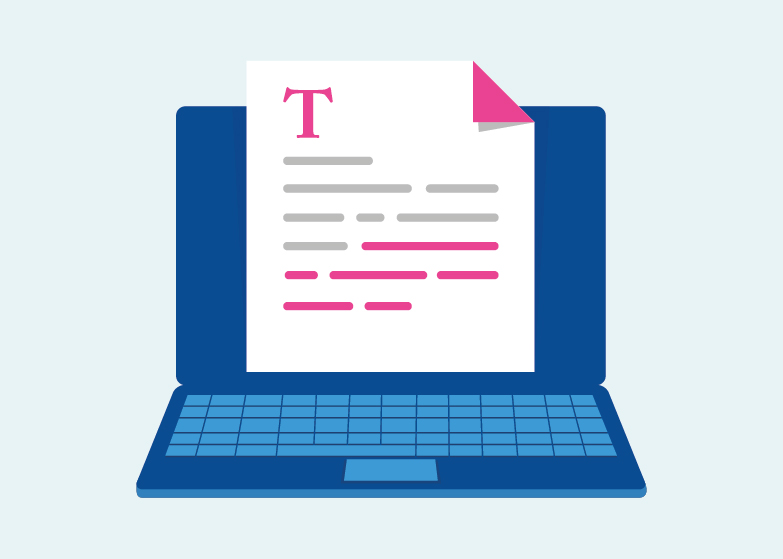
Academic Writer ®
Master academic writing with APA’s essential teaching and learning resource

Course Adoption
Teaching APA Style? Become a course adopter of the 7th edition Publication Manual

Instructional Aids
Guides, checklists, webinars, tutorials, and sample papers for anyone looking to improve their knowledge of APA Style
A clear, arguable thesis will tell your readers where you are going to end up, but it can also help you figure out how to get them there. Put your thesis at the top of a blank page and then make a list of the points you will need to make to argue that thesis effectively.
For example, consider this example from the thesis handout : While Sandel argues persuasively that our instinct to “remake”(54) ourselves into something ever more perfect is a problem, his belief that we can always draw a line between what is medically necessary and what makes us simply “better than well”(51) is less convincing.
To argue this thesis, the author needs to do the following:
- Show what is persuasive about Sandel’s claims about the problems with striving for perfection.
- Show what is not convincing about Sandel’s claim that we can clearly distinguish between medically necessary enhancements and other enhancements.
Once you have broken down your thesis into main claims, you can then think about what sub-claims you will need to make in order to support each of those main claims. That step might look like this:
- Evidence that Sandel provides to support this claim
- Discussion of why this evidence is convincing even in light of potential counterarguments
- Discussion of cases when medically necessary enhancement and non-medical enhancement cannot be easily distinguished
- Analysis of what those cases mean for Sandel’s argument
- Consideration of counterarguments (what Sandel might say in response to this section of your argument)
Each argument you will make in an essay will be different, but this strategy will often be a useful first step in figuring out the path of your argument.
Strategy #2: Use subheadings, even if you remove them later
Scientific papers generally include standard subheadings to delineate different sections of the paper, including “introduction,” “methods,” and “discussion.” Even when you are not required to use subheadings, it can be helpful to put them into an early draft to help you see what you’ve written and to begin to think about how your ideas fit together. You can do this by typing subheadings above the sections of your draft.
If you’re having trouble figuring out how your ideas fit together, try beginning with informal subheadings like these:
- Introduction
- Explain the author’s main point
- Show why this main point doesn’t hold up when we consider this other example
- Explain the implications of what I’ve shown for our understanding of the author
- Show how that changes our understanding of the topic
For longer papers, you may decide to include subheadings to guide your reader through your argument. In those cases, you would need to revise your informal subheadings to be more useful for your readers. For example, if you have initially written in something like “explain the author’s main point,” your final subheading might be something like “Sandel’s main argument” or “Sandel’s opposition to genetic enhancement.” In other cases, once you have the key pieces of your argument in place, you will be able to remove the subheadings.
Strategy #3: Create a reverse outline from your draft
While you may have learned to outline a paper before writing a draft, this step is often difficult because our ideas develop as we write. In some cases, it can be more helpful to write a draft in which you get all of your ideas out and then do a “reverse outline” of what you’ve already written. This doesn’t have to be formal; you can just make a list of the point in each paragraph of your draft and then ask these questions:
- Are those points in an order that makes sense to you?
- Are there gaps in your argument?
- Do the topic sentences of the paragraphs clearly state these main points?
- Do you have more than one paragraph that focuses on the same point? If so, do you need both paragraphs?
- Do you have some paragraphs that include too many points? If so, would it make more sense to split them up?
- Do you make points near the end of the draft that would be more effective earlier in your paper?
- Are there points missing from this draft?
- picture_as_pdf Tips for Organizing Your Essay

Academic Essay
Essay generator.
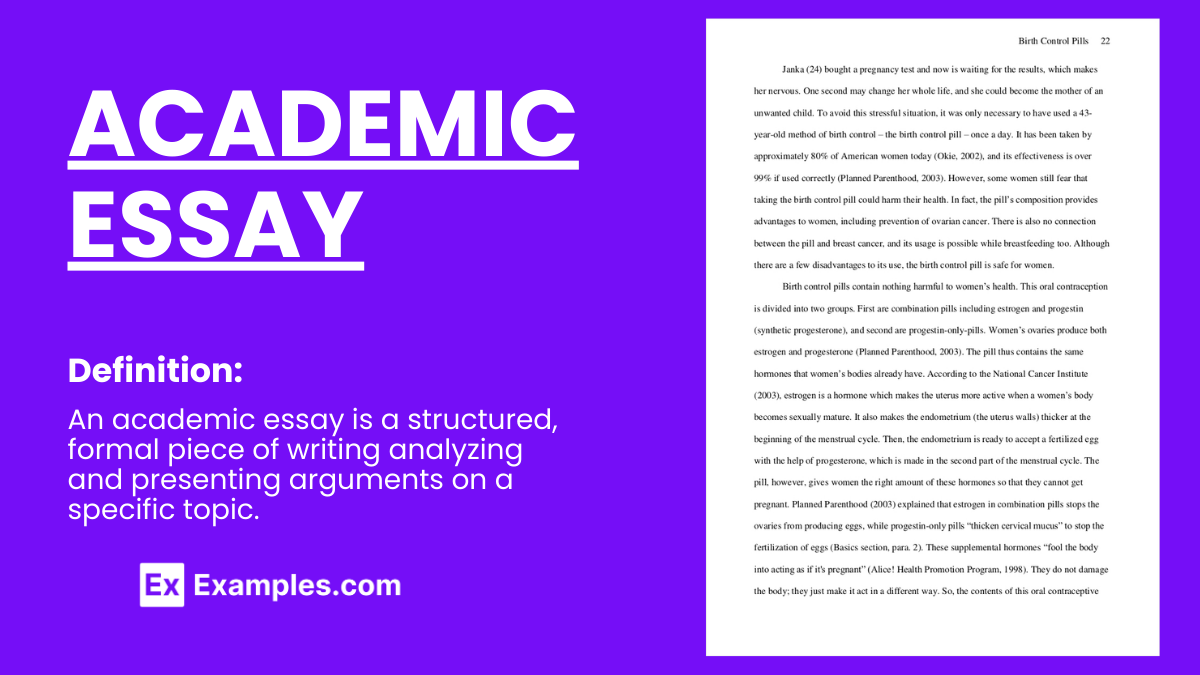
When creating an academic essay , it is very important for you to relay a sensible and clear argument to your target readers. Since academic essays are widely used in the field of education and research, you need to ensure that you do both logical, interesting and informative writing . The items that are commonly seen in an academic essay contain insights, actual occurrences, ideas, and facts.
What is Academic Essay?
An academic essay is a structured form of writing that serves the purpose of presenting and supporting a thesis or argument on a specific topic. It is commonly used in educational settings to assess students’ understanding, analytical skills, and ability to research and convey their findings. An academic essay typically follows a clear format, including an introduction with a thesis statement, body paragraphs that provide evidence and analysis to support the thesis, and a conclusion that summarizes the main points and reinforces the essay’s central argument. This type of essay requires critical thinking and a formal tone, with evidence cited from reputable sources to back up claims made within the text.
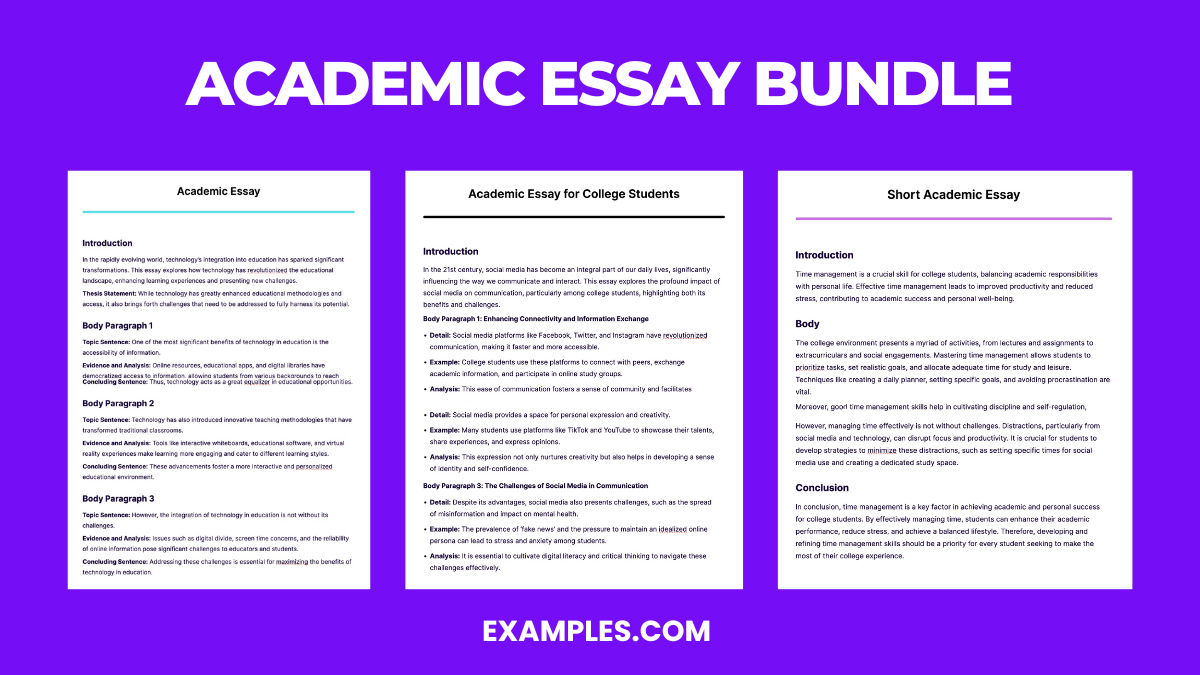
Download Academic Essay Bundle
A lot of students tend to think that an academic essay, just like any other college essay , is something that is too technical or defined. However, you can always write one depending on how you perceive a specific topic of discussion or how you interpret an instance or any other subjects. The samples that we have for you can be a great help if you would like to start writing your academic essay already.
Academic Essay Writing Format/ Outline
1. title page (if required).
Includes the essay’s title, the author’s name, and institutional affiliation.
2. Introduction
Hook : Opens with a statement to grab the reader’s interest. Background Information : Provides context for the topic being discussed. Thesis Statement : Presents the main argument or claim of the essay.
3. Body Paragraphs
Each paragraph should focus on a single idea that supports the thesis, structured as follows:
Topic Sentence : Introduces the main idea of the paragraph. Evidence and Analysis : Includes data, quotes, or examples to support the topic sentence, followed by an explanation of how this evidence supports the thesis. Transition : Connects to the next paragraph or idea.
4. Conclusion
Summary of Main Points : Restates the key arguments or findings presented in the body paragraphs. Restatement of Thesis : Reinforces the essay’s main argument in light of the evidence presented. Closing Thought : Offers a final insight, a call to action, or a suggestion for further research.
Example of Academic Essay Writing
The Impact of Social Media on Communication In the digital age, social media has revolutionized the way we communicate, transcending physical boundaries and transforming social interactions. This essay explores the profound impact of social media on communication, examining both its positive advancements and negative implications. While social media platforms like Facebook, Twitter, and Instagram have enhanced our ability to connect with others, they have also led to a decline in face-to-face interactions and a dilution of personal communication skills. Social media has made it easier than ever to stay connected with friends and family, regardless of geographical distance. A study by Smith and Duggan (2016) found that 75% of internet users utilize social media to maintain relationships with distant family and friends. This widespread use of social media for keeping in touch demonstrates its role as a vital communication tool, bridging the gap between people worldwide. However, the reliance on social media for communication has led to a decrease in the quality of interpersonal interactions. Research by Johnson (2018) indicates a 40% decline in face-to-face conversations among young adults, correlating with increased social media usage. The preference for digital communication over personal interaction suggests a shift in social dynamics, potentially harming relational depth and emotional connections. Moreover, social media has affected our communication skills, particularly among younger generations. A survey by Lee (2019) revealed that 60% of teachers believe social media use has adversely affected students’ writing and verbal communication skills. The informal language and abbreviations common in social media posts and messages are infiltrating academic and professional communications, underscoring the need for a balanced approach to digital interactions. Social media has undeniably transformed communication, offering unparalleled connectivity but also presenting significant challenges. While it fosters global connections, its overuse can undermine personal interactions and communication skills. Balancing social media use with face-to-face communication is crucial for maintaining meaningful relationships and effective communication in the 21st century.
What is an example of academic writing?
Title: The Impact of Climate Change on Biodiversity
Introduction: Climate change, driven primarily by human activities such as the burning of fossil fuels and deforestation, has emerged as a critical global concern. This essay aims to explore the multifaceted impacts of climate change on biodiversity. The effects of rising temperatures, altered weather patterns, and habitat destruction are increasingly evident, with far-reaching consequences for ecosystems and species worldwide.
Body Paragraph: One of the most noticeable consequences of climate change is the shifting geographical ranges of numerous species. Warmer temperatures prompt species to migrate to higher altitudes or latitudes, as they seek habitats that align with their thermal preferences. This phenomenon is evident in various ecosystems, including mountain regions, where alpine plants and animals have progressively moved uphill. These migrations, while adaptive, can disrupt established predator-prey relationships and competition for resources. Such shifts can also lead to reduced biodiversity in lower-altitude regions as some species fail to adapt or relocate successfully.
- Smith, J., & Johnson, A. (2019). Impacts of Climate Change on Alpine Plant Communities. Environmental Studies Journal , 42(3), 256-270.
- Wilson, P., & Davis, R. (2020). Climate-Induced Shifts in Animal Distributions: Evidence from a Decadal Study. Ecology and Evolution , 10(12), 5963-5972.
Conclusion:
In conclusion, climate change exerts profound effects on biodiversity, manifesting through shifts in species distributions, altered ecological relationships, and habitat loss. As global temperatures continue to rise, addressing these impacts becomes increasingly urgent. Conservation efforts, sustainable practices, and international cooperation are essential in mitigating the repercussions of climate change on the world’s diverse ecosystems and species.
Academic Essay Topics with Samples to Edit & Download
- Pollution due to urbanization
- The environmental causes of smoking
- The outcomes of global warming
- Abortion as a controversy
- Causes of obesity in teenagers
- Childhood memories
- Fathers should get equal paternity leave
- Harmful dogs should be euthanized
- How does divorce affects children?
- How does technology affect productivity?
- Importance of preserving threatened species
- Parenting styles and motives
- Political issues in the U.S.
- Romantic relationships
- Should schools abolish homework?
- Violent video games should be banned
- Ways of protecting the environment
Academic Essay Writing Examples & Templates
1. academic essay example.

Free Download in PDF
2. Academic Essay for College Students
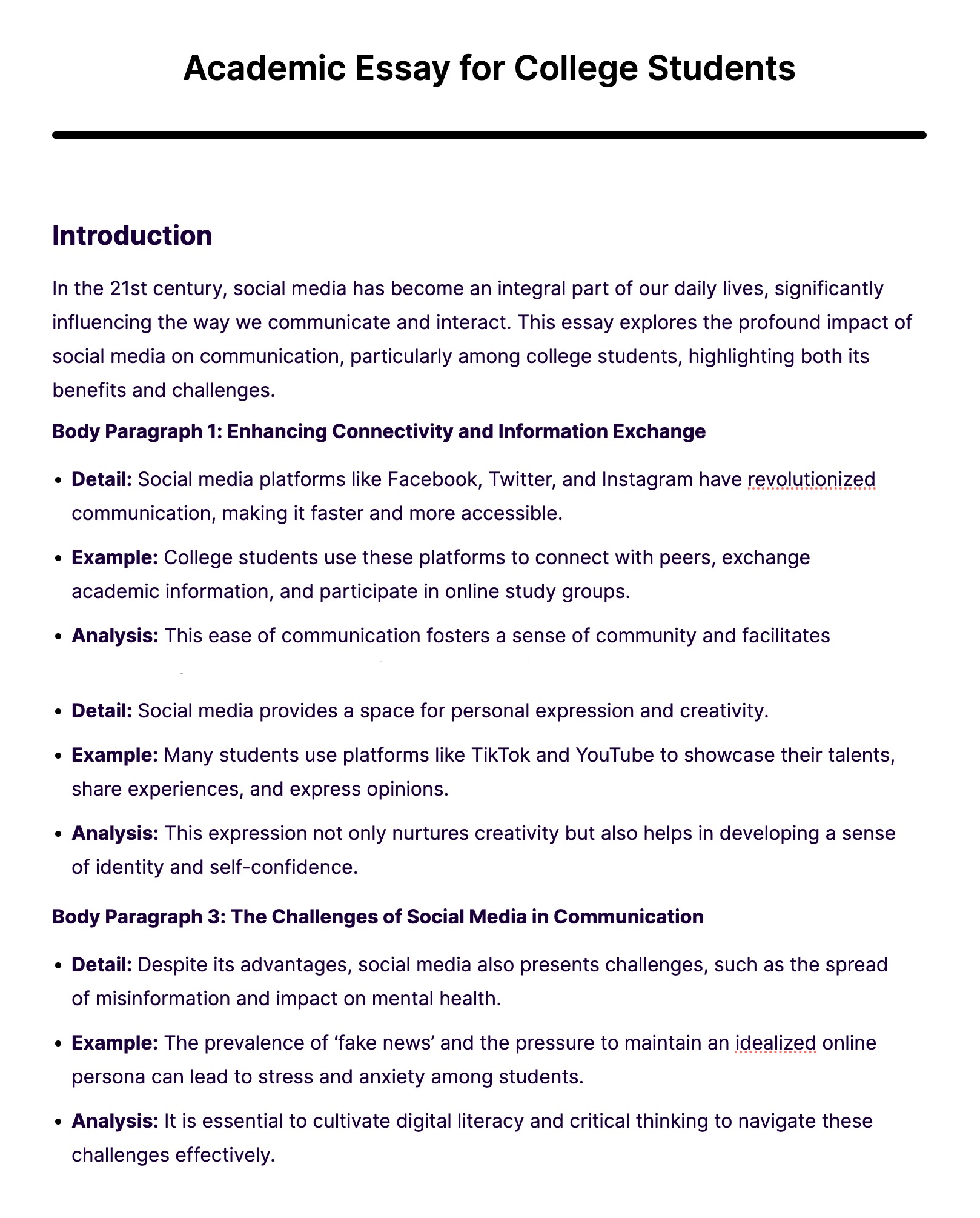
Edit & Download
3. Short Academic Essay
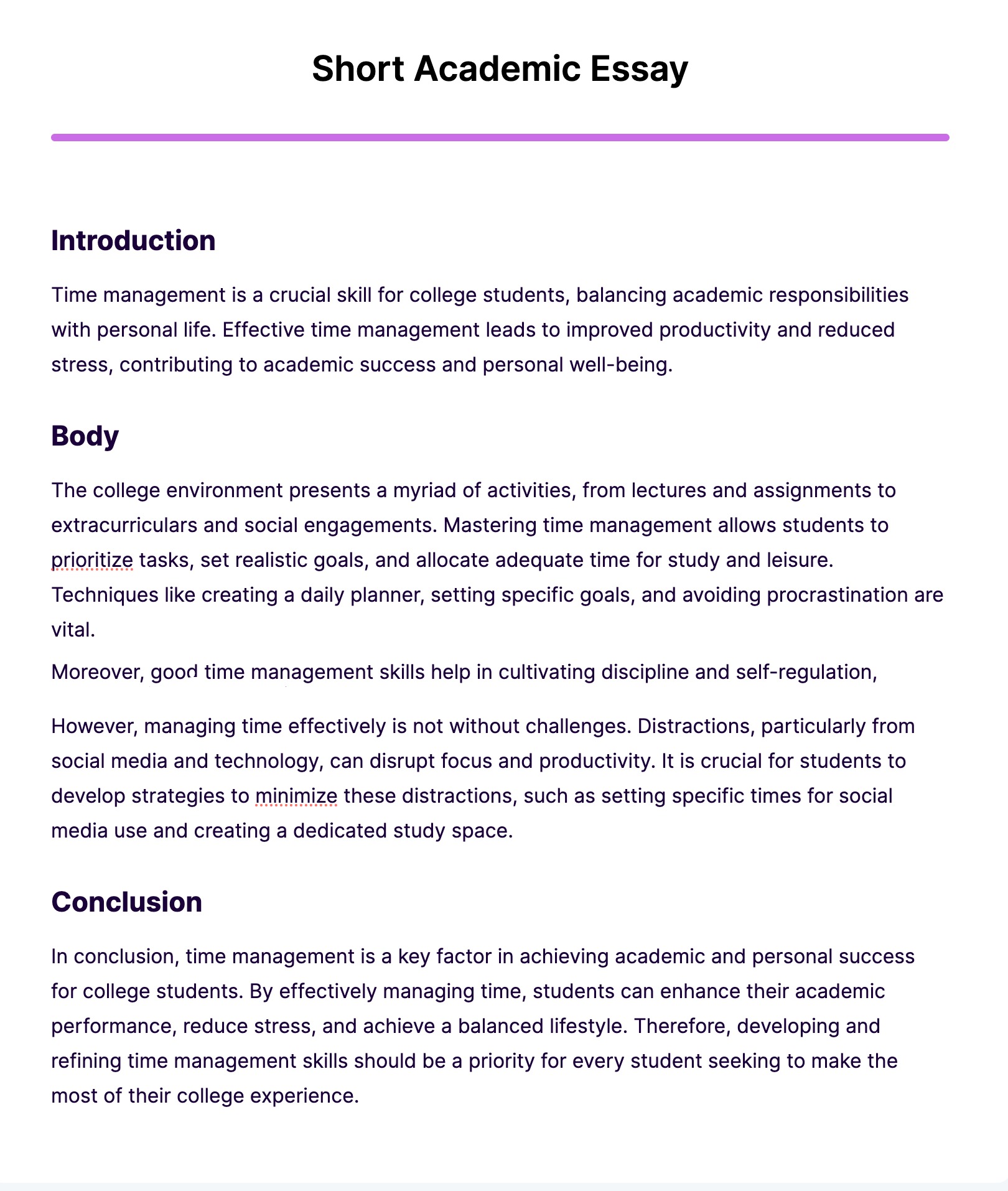
4. Academic Essay Template
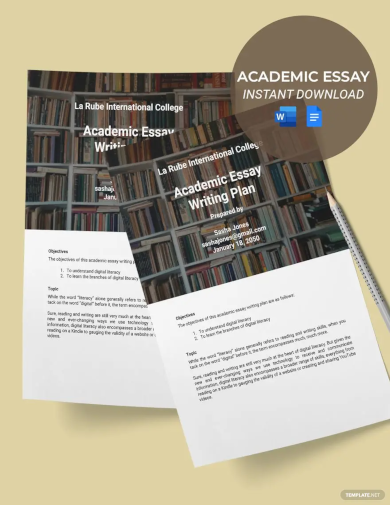
5. Academic Writing Essay Template
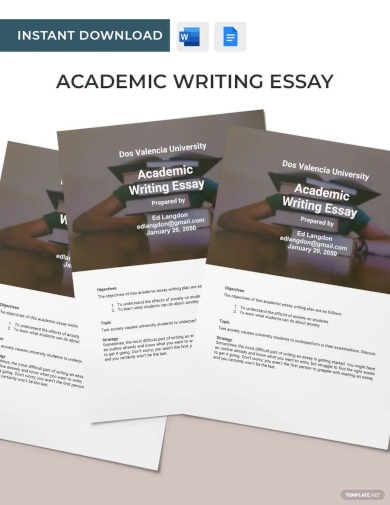

6. Academic Text Example Essay Template
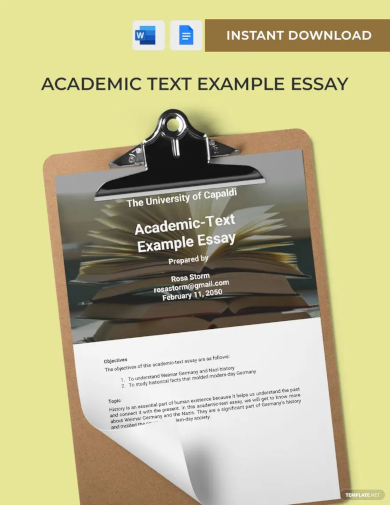
7. Academic Essay Writing Examples
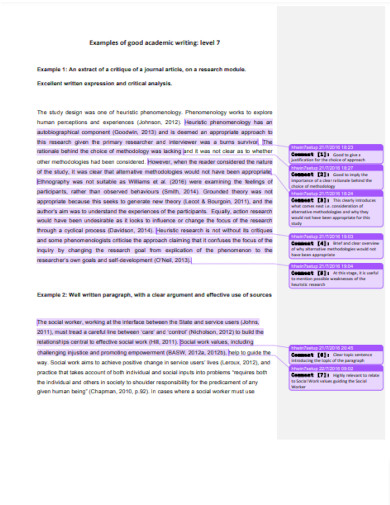
academic-skills.health.herts.ac.uk
8. Academic Essay for College Students Examples

9. Narrative Academic Essay Examples
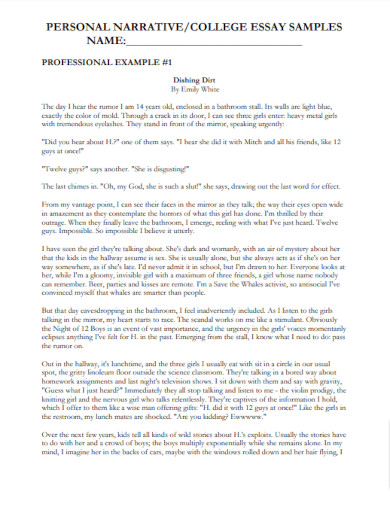
learning.hccs.edu
10. Sample Academic Essay Format Example
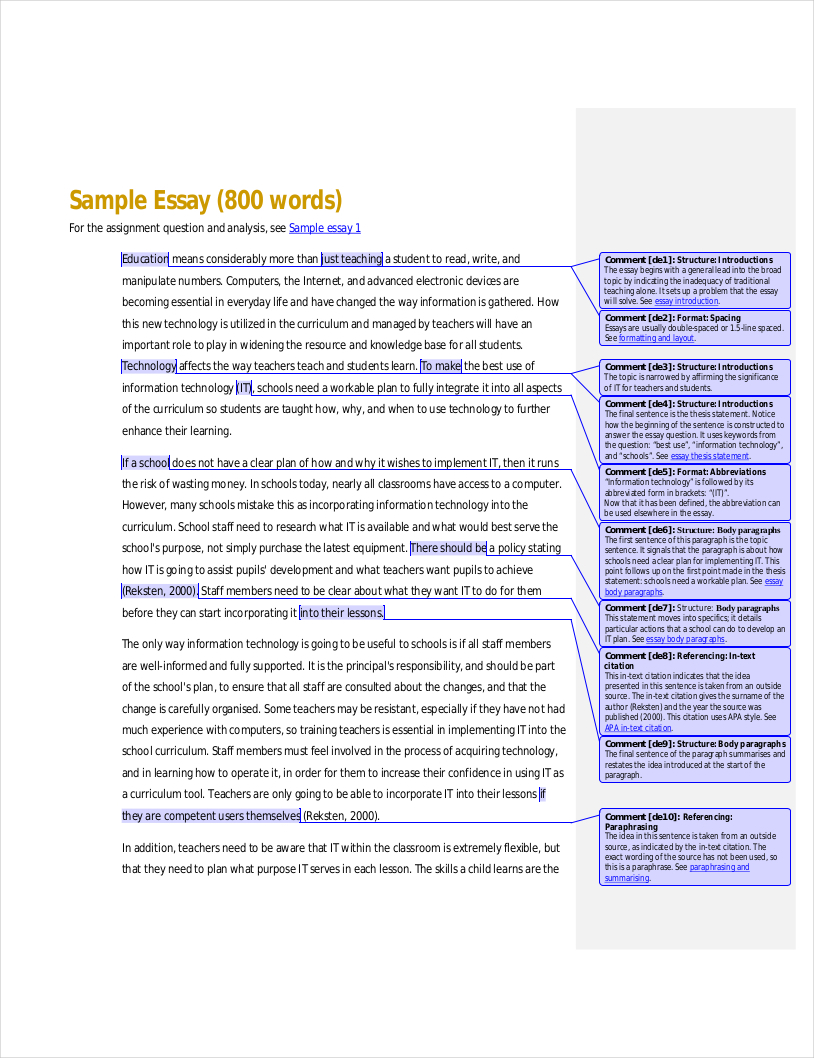
owll.massey.ac.nz
11. Academic Paper Essay Example
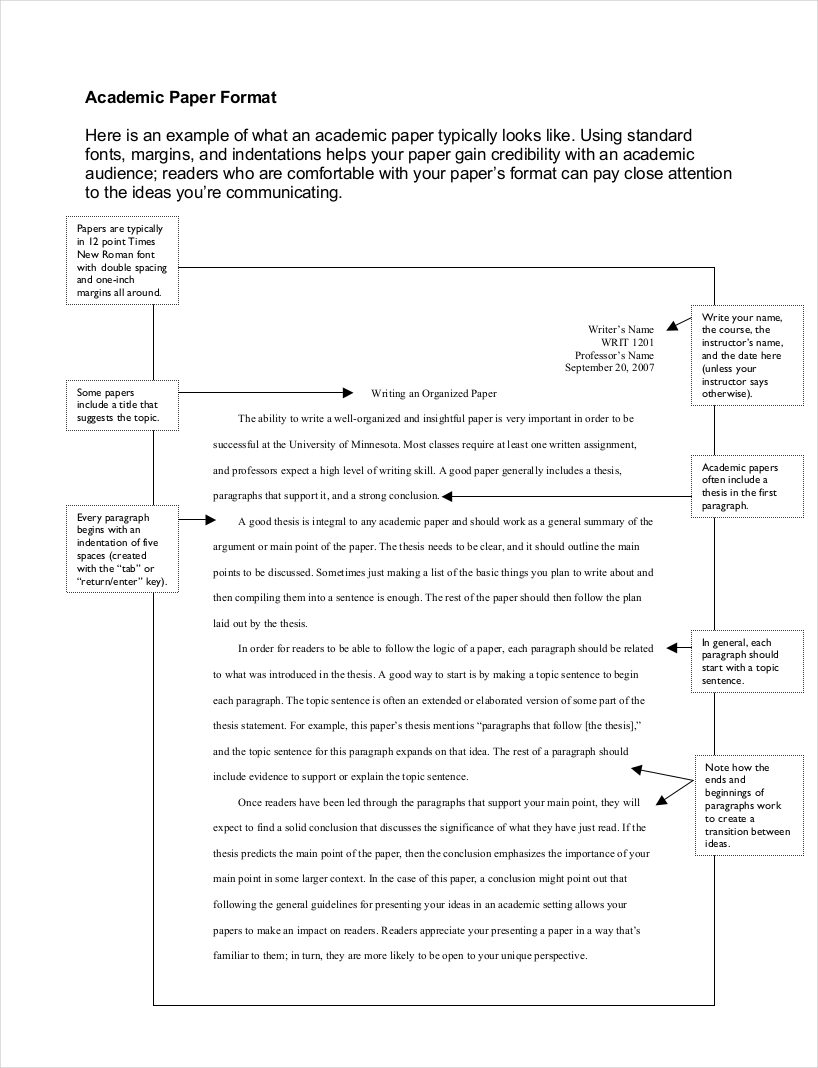
writing.umn.edu
12. Simple Academic Essay Example

cambridgemichigan.org
13. Academic Essay Sample Structure Example
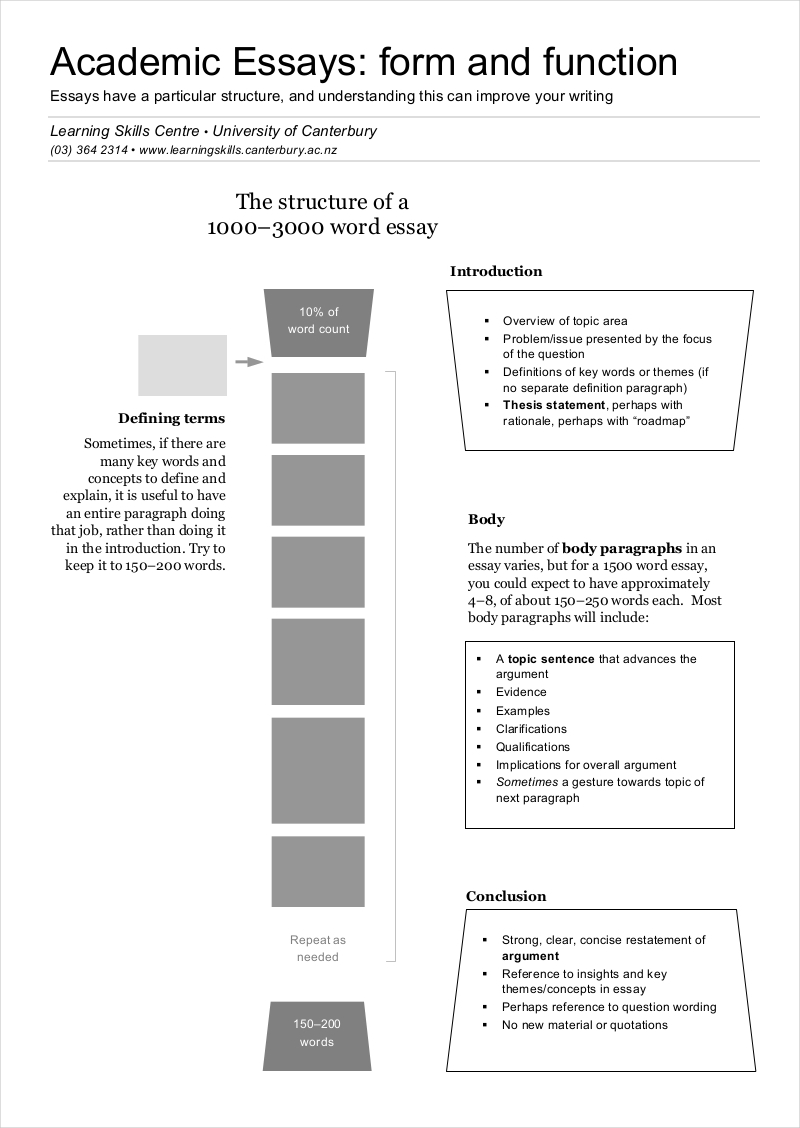
lps.canterbury.ac.nz
14. Short Academic Essay Example in PDF
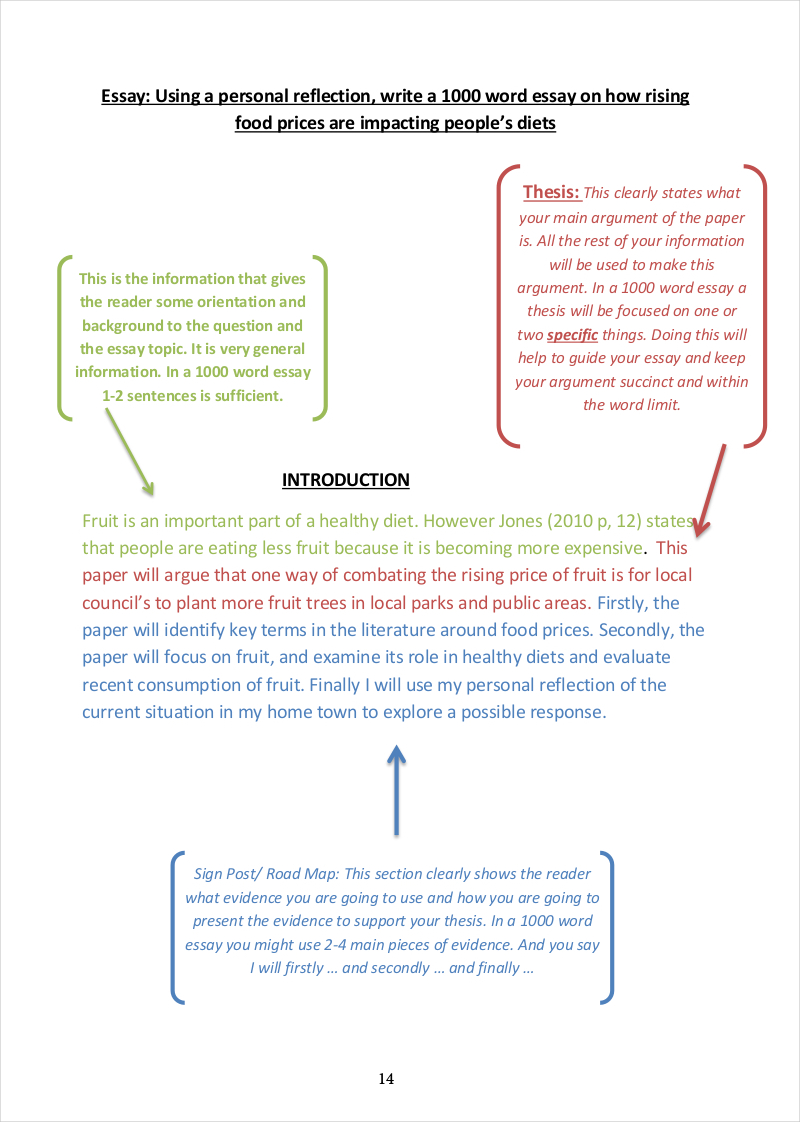
15. Free Printable Academic Essay Sample
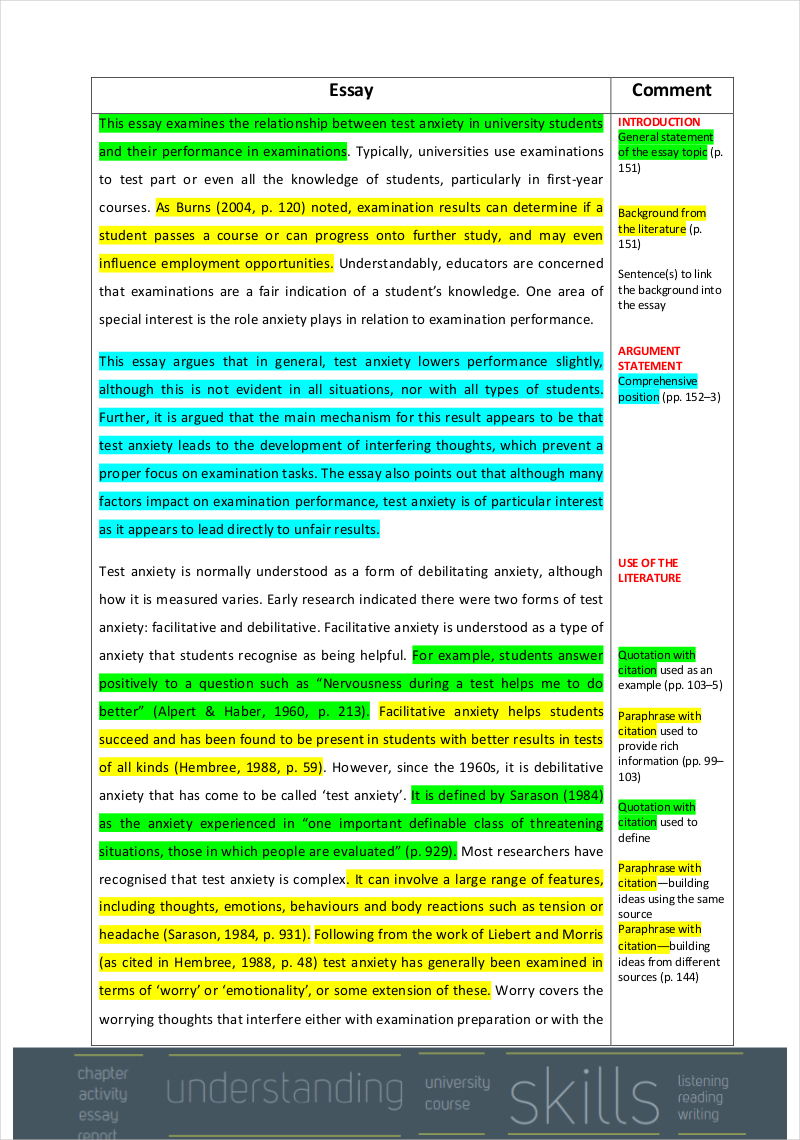
lib.oup.com.au
16. Sample Academic Essay Example
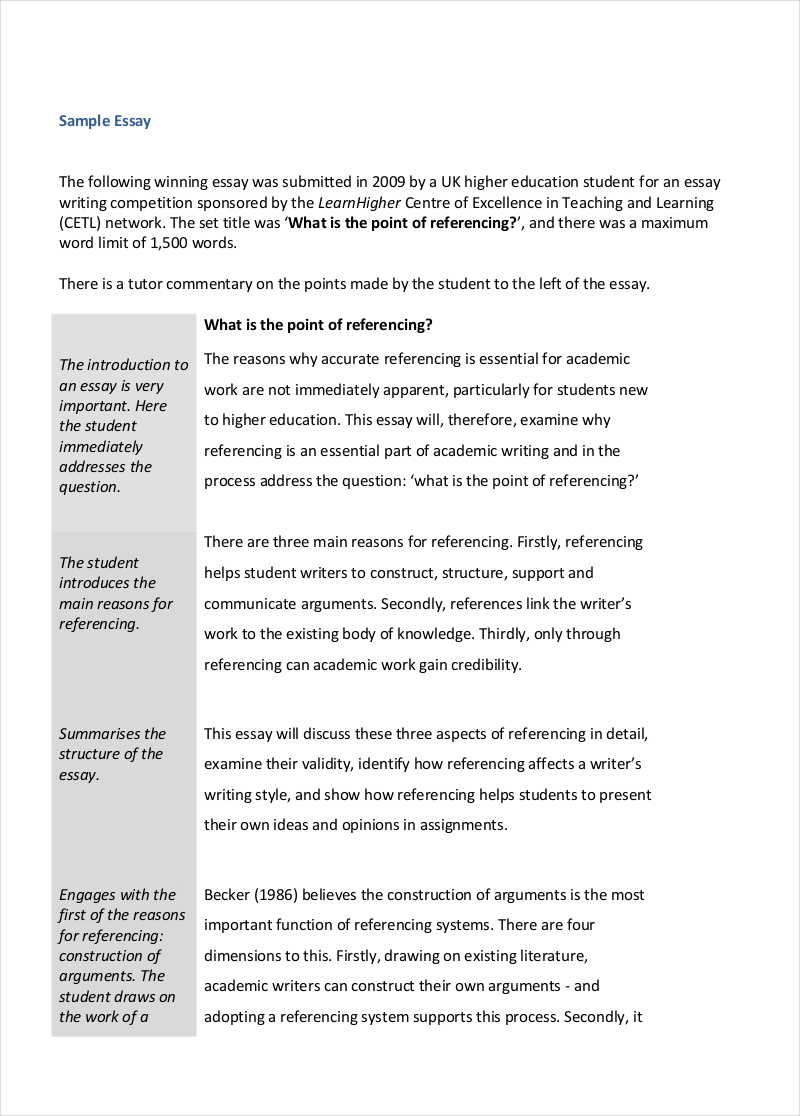
17. Academic Essay Writing Sample Example
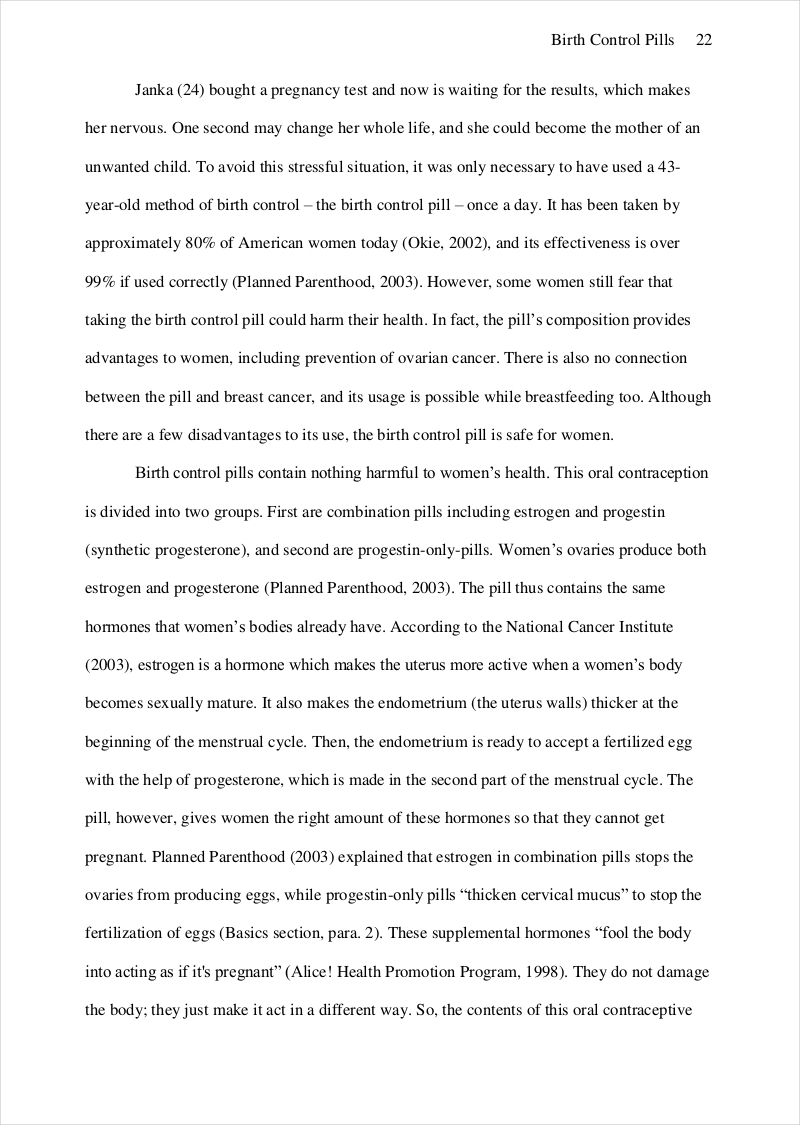
18. Free Academic Essay Sample Guide
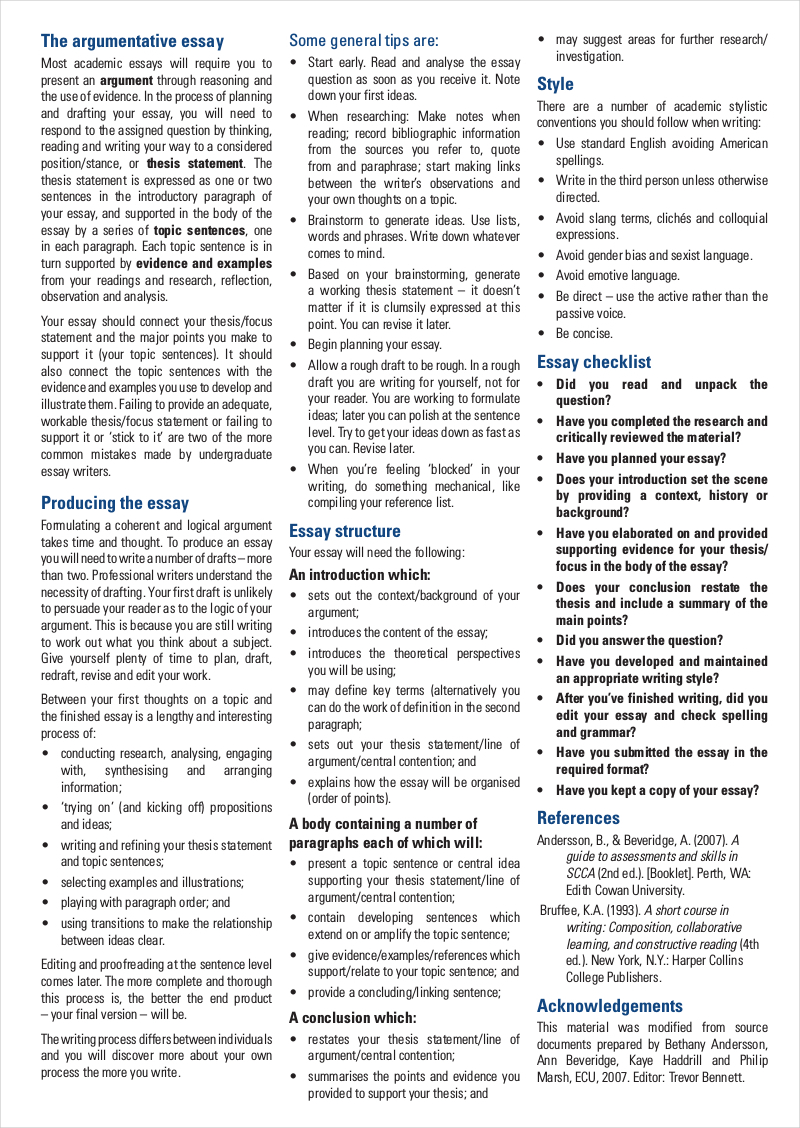
intranet.ecu.edu.au
19. Sample Academic Essay Outline
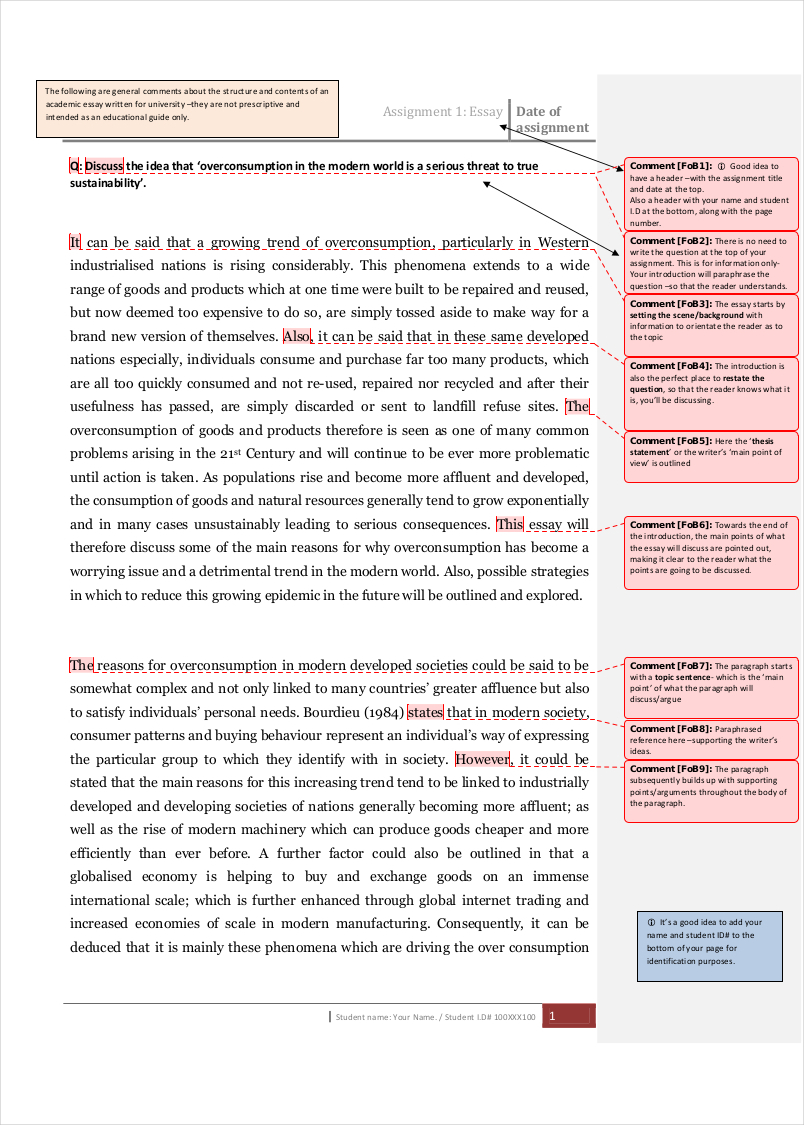
lib.uts.edu.au
Are You Ready and Prepared to Create an Academic Essay?
Different types of academic writing require an individual to have a clear thought process within the entirety of idea development. You have to be focused on what you would like to achieve your final written output so you can incorporate successful guides and processes within the activity. Some of the things that you can talk about in an academic essay include the following:
- Human behavior, characteristics, and emotions
- Community relations
- Natural occurrences
- Language and its effective usages
- Culture and the arts
- Academic researchers
- Relevant cultural phenomenon
- Photography and other artistic undertakings
- Human interactions
- Other subjects that are related to education and academics
Knowing the subject of your article is only one of the initial things that can help you prepare during the writing process. Here are some ways on how you can be ready to write your academic essay:
- You need to have an order of writing that can easily showcase the flow of your thoughts. You must ensure that you can easily connect with your readers or audience so they can respond to the content of your article. Your academic essay should evoke an emotion that is necessary to spark other ideas, opinions and other kinds of responses.
- You need to be aware that academic essays differ depending on the educational or academic discipline where they will be used. There are certain ways that are necessary to be followed in various fields for an academic essay to be deemed effective. With this, always be mindful of the directions or instructions were given to you by the entity who requires you to write an academic essay.
- You do not need to pattern your writing to the works of others. You can be ready even by just knowing your subject and researching about it. The style of writing that you have can give the most difference to how you write and how you present your work. Always keep in mind that your academic essay should be playful – it must not bore your audience.
- You must think of your academic essay as an enterprise by using scholastic writing approaches. The conversation that you can create with your readers must be relevant to what is happening nowadays or for the study that specific student groups need. Being able to give focus on the relativity of your written work can make it easier for readers to understand why your academic essay is important within the academic field.
- You should ensure that your thesis statement is precise, concise, and strong. When you are in the process of developing your academic essay’s thesis, you need to make sure that you are not just basing your write-up on unreliable information. Always refer to evidence, facts, and real data as it can help you strengthen your claims. More so, do not forget to reference your essays when necessary.
Things to Remember When Identifying the Purpose of Your Academic Essay
An academic essay always has to be relevant. It needs to be beneficial to a specific group or to the majority of the academic community. The motive of your essay is very important to be considered as it can identify whether you can be of help to the people who need a particular educational reference. Here are a few things that you need to remember when identifying the purpose of your own academic essay:
- Do not create an academic essay just for the sake of passing it. Your academic essay is more than an assignment or a project. There are some last minute essay writing activities that are done in various fields especially if students think that an academic essay is just a part of their requirements. However, what these students do not know is that an academic essay is a representation of themselves. It showcases the thoughts of the students, what they have learned may it be in class or through self-discovery, and how they are impacted by certain issues and subjects of discussion. This is where the value of a Free Essay and an Informative Essay becomes evident, as both types of essays encourage students to express their understanding and insights on a given topic freely and informatively.
- Be precise with the purpose of your writing. An academic letter is not just a document that can showcase your mastery when it comes to a particular academic subject. It can talk about a specific subject or it can also be a general paper that can provide a lot of information about your experiences and/or insights. This is where the importance of a Self-Introduction Essay comes into play, allowing you to present a personal narrative that reflects your academic journey and achievements. Similarly, an Expository Essay helps in laying out facts and an unbiased analysis of a topic, further enriching the academic discourse. If you will have a precise purpose when writing an academic essay, there is no doubt that your essay will not be pointless.
- Always think of the best case that can help you represent your thoughts. Your style of writing, as well as the entire document’s format and content, can help you realize your ideas. This includes the succinctness and clarity often found in a Short Essay , where the challenge is to convey your thoughts within a limited word count effectively. Similarly, a Scholarship Essay requires you to articulate your achievements and aspirations in a way that resonates with scholarship committees, demonstrating your potential and need for financial support. With this, your point of writing can easily be identified by readers. Being able to present your purpose the best way possible can add up to the success of your academic paper.
Developing an Academic Essay
For you to be able to persuade your readers with the content of your academic essay, there is a need for you to present a structure that can easily identify your claims, arguments, observations, and/or factual presentations. Integrating a Student Essay can demonstrate the personal perspective or learning journey of an individual, making your arguments more relatable. Similarly, incorporating a Travel Essay could enrich your essay by providing unique insights and observations from different cultures or environments. Being clear about how you present your idea is essential for people to see the context of your academic essay.
If you have an organized manner of putting together the concepts of your academic essay, then validating your thesis statement can be more evident. To avoid common essay mistakes and other negative factors that can affect your desired output, here is a basic guide on how you can develop your own academic essay:
- Start by creating a strong thesis statement. Identify your stand and make sure to strictly present evidence that can help you claim its authenticity and validity. Reveal evidence after your thesis statement presentation. Your thesis statement serves as your introduction speech . It lets your readers know the topic of your academic essay and what they can expect from the entire article.
- Establish the context of your essay after your thesis statement. The way that you approach your topic can let readers know whether it is the specific approach that they also need for their undertakings. There are different contexts that can be used within the same subject, so you have to make sure that you will be clear when it comes to identifying the part of the topic that you are going to talk about. This clarity can be achieved through a Descriptive Essay , where vivid descriptions and details about the topic can enlighten and engage the reader. Additionally, understanding the Parts of an Essay is crucial in structuring your thoughts and arguments effectively. Limiting your topic discussion can help you give more focus to what is important for your discussion, ensuring that each part contributes meaningfully to the whole.
- Create the next paragraphs based on the data that can support your thesis statement. The body of your academic essay can be based on your observations, reviews, statements and research outputs. You can present these items separately through the usage of various paragraphs. However, there are instances where it will be better if you can combine or compare to evidence to make your statements more effective.
- Conclude. Your conclusion is as important as your introduction. If you believe that you have created a strong introduction, you have to maintain that until the end of your academic essay. Sum up all the information that you have presented so that people can identify whether your conclusion has lived up to the content of what you have written. Your conclusion can also be used to assess whether your thesis statement has been carried within the entirety of your discussion.
Importance of a Well-Defined Thesis Statement in an Academic Essay
A thesis statement is a paragraph or a set of paragraphs that identifies your stand about your subject. There is a need for this statement to be created as it can affect the entirety of your academic paper. Here are some of the reasons why it is important to develop an effective thesis statement before and while writing your academic paper:
- Your thesis statement is a reflection of your actual idea. This helps you present the point that you would like to make and the message that you actually want to disseminate to your readers. Through a thesis statement, you can organize the evidence that are relevant to your claims based on their relevance to the topic and how you view it as a writer.
- Your thesis statement can guide you within the entirety of your writing processes. Just because you have already done an initial thesis statement does not mean that you are going to fully stick with it until the end of your writing. There are instances where thesis statements are developed or even changes during the creation of an academic essay depending on how the research about the topic has evolved.
- Your thesis statement can allow you to establish originality. Since your academic essay can be based on your research findings and observations, your thesis statement can be your platform to specify what you have come up with. Through a well-defined thesis statement, you can set your output apart from other essay examples that have been written by professionals and other entities in the field of academics.
- Your thesis statement is one of the items that the audience will look at when referencing for credibility and validity. Academic essays need to have a strong initial impact on readers. This statement can help them be focused on a particular standpoint which can enlighten them about your views and opinions, and how these are essential to be considered.
- Your thesis statement can help your readers immerse in your academic essay. The material that you will be coming up with can be reviewed by different people. Depending on the field of education where you are currently in, you need to make sure that your readers can see patterns of evidence presented so they can clearly see how you were able to generate and come up with insights. You have to ensure that the thesis statement that you have created contains the most promising thought so you can get the trust or even the acceptance of your readers about your academic essay’s subject.
Guidelines in Writing an Academic Essay
The course materials that you need to talk about within an academic essay can reflect your level of understanding about the subject. Simply put, an academic essay can be an evidence of the depth of your research procedures and all the other activities that you have executed so that you can support the content of your written output. Listed below are some of the guidelines that can be useful to your academic essay writing processes.
- Always analyze your essay prompt or the question that you need to answer or explain. You have to know whether you are tasked to argue, analyze, or discuss the topic. There will be times where you also need to compare the items present in your subject or explain the underlying factors that can affect your topic.
- Make sure that you will research about what you will write about . Your academic essay can only be fully-maximized if you can present facts. Primary research may be a helpful bit a more precise review of your research topic can help you gather more information that can be helpful in the development of your content. Always assess your sources of information so you can ensure that they are credible.
- Create a draft so that you will have a guide when writing your academic essay. If you will be organized when writing your academic essay, you can create an output that is well-curated and comprehensive. With this, your academic essay can provide more impact to your readers. This can also help you gather your thoughts first and identify how you can put them all together in the most cohesive and efficient way possible.
If you still do not feel confident in writing your own academic essay from scratch, then you can refer to templates and samples which you can download online. Doing this will allow you to be more familiar with the common content and basic formats that are usually seen in an academic essay. When using a template as a guide, always make sure that it is applicable to the study that you are practicing or the academic field or discipline where you will use your academic essay.
As a student, there will always be an instance where we will be required to write an academic essay. If you want to create an academic essay that is both outstanding and relevant, always put the items that we have discussed above in mind.
Setting the Stage for Essay Writing Success
- Understand the Assignment: Carefully read and comprehend the essay prompt or assignment to grasp its requirements and objectives.
- Topic Selection: Choose a relevant and interesting topic that aligns with the assignment.
- Research: Gather credible sources and information related to your topic. Take thorough notes and document your sources.
- Thesis Statement: Develop a strong, clear, and concise thesis statement that presents the main argument of your essay.
- Outline: Create an outline that organizes your essay into sections, including the introduction, body paragraphs, and conclusion. Each section should have a clear purpose.
- Writing Draft: Begin writing your essay, keeping the introduction engaging, and ensuring each body paragraph addresses a single point or idea supported by evidence.
- Citations: Properly cite sources as you write, following a recognized citation style (e.g., APA, MLA).
- Edit and Revise: Review and revise your draft, focusing on grammar, clarity, coherence, and organization.
- Proofread: Carefully proofread your essay for errors in spelling, punctuation, and sentence structure.
- Final Review: Double-check that your essay fulfills the assignment requirements, including formatting, citations, and references.
How do you write an academic essay?
- Understand the Assignment: Read the essay prompt or assignment thoroughly to grasp its requirements and objectives.
- Research: Gather relevant sources and information from books, articles, and credible online sources.
- Plan and Outline: Create an outline with an introduction, body paragraphs, and a conclusion. Each section should have a clear purpose.
- Thesis Statement: Develop a strong thesis statement that presents the main argument of your essay.
- Introduction: Start with a compelling hook, provide background information, and present your thesis statement.
- Body Paragraphs: Each paragraph should focus on a single point or idea, supported by evidence or examples. Use topic sentences to introduce the main idea of each paragraph.
- Citations: Cite sources properly using a recognized citation style (e.g., APA, MLA, Chicago).
- Analysis and Critical Thinking: Analyze and evaluate the evidence or arguments presented, and make connections between them.
- Transition Sentences: Use transition words and phrases to connect ideas between paragraphs.
- Conclusion: Summarize the main points, restate the thesis, and provide a thoughtful conclusion that leaves a lasting impression.
Academic Essay Characteristics
Academic essays are distinguished by several key characteristics that set them apart from other types of writing. These features ensure that essays meet the rigorous standards of academic discourse and contribute effectively to scholarly conversations. Here are the primary characteristics of academic essays:
- Clear Purpose : An academic essay is written with a clear purpose, often to argue a point, present an analysis, or discuss a research finding. The purpose guides the structure and content of the essay.
- Structured Format : It follows a structured format with an introduction, body paragraphs, and a conclusion. This organization helps present arguments and evidence in a coherent and logical manner.
- Thesis Statement : A distinctive feature is the thesis statement, a concise summary of the main argument or claim, usually found at the end of the introduction. It sets the direction for the entire essay.
- Critical Analysis : Academic essays involve critical analysis of ideas, texts, or situations. Writers assess evidence, debate viewpoints, and use logic to develop their arguments.
- Evidence-Based Arguments : Claims made in academic essays are supported by evidence from credible sources. This includes data, statistics, research findings, and quotations from experts.
- Formal Tone and Style : The writing adopts a formal tone and style, avoiding colloquial language, personal anecdotes (unless relevant), and slang. It maintains an objective and professional voice.
Types of Academic Writing
Academic writing encompasses a variety of types, each serving a specific purpose and adhering to a particular format. Here are some of the main types of academic writing:
- Descriptive Writing : This type focuses on describing a character, event, or situation in detail. It’s often used in reports or descriptive essays, where the goal is to provide a clear picture of the subject to the reader.
- Analytical Writing : Analytical writing breaks down complex information into smaller components for better understanding. It involves comparing and contrasting, classifying, and analyzing causes and effects. This type is common in research papers and literature reviews.
- Persuasive Writing : Persuasive writing aims to convince the reader of the writer’s viewpoint or argument. It is characterized by a strong thesis statement, clear evidence, and logical reasoning to persuade the reader. Opinion pieces, argumentative essays, and proposals often employ persuasive writing.
- Expository Writing : Expository writing is used to explain or inform the reader about a specific topic in a clear, concise, and logical manner. It focuses on presenting facts, statistics, and examples without the writer’s personal opinions. This type includes most essays, many types of reports, and certain types of research papers.
- Reflective Writing : This type involves the writer reflecting on their personal experiences, thoughts, or feelings regarding a particular subject or experience. Reflective writing is subjective and is often used in journals, blogs, and reflection essays in educational settings.
- Critical Writing : Critical writing evaluates and critiques the work of others, such as books, articles, or artworks. It involves assessing the strengths and weaknesses of arguments, evidence, and methodologies. Literature reviews, critique essays, and certain types of research papers often require critical writing.
- Narrative Writing : Although less common in strict academic settings, narrative writing is used in certain disciplines to tell stories or describe events chronologically. Personal statements and some types of qualitative research may employ narrative writing to convey experiences and observations.
- Report Writing : Reports convey information from a writer to a reader, focusing on facts and evidence. They are structured and include sections like an introduction, methodology, findings, and conclusions. Lab reports, business reports, and technical reports are examples of this type.
Academic Writing Principles
Academic writing is governed by a set of core principles designed to ensure clarity, precision, and rigor in scholarly communication. Understanding and adhering to these principles is essential for effective academic writing. Here are the key principles:
- Clarity : Writing should be clear and understandable, avoiding unnecessary jargon and complexity to ensure that the reader can easily follow the argument or narrative.
- Coherence : The text should be logically organized, with a clear structure that guides the reader through the argument or discussion. Each part of the writing should connect to the others in a meaningful way.
- Conciseness : Academic writing should be concise, conveying ideas in as few words as necessary. This does not mean oversimplifying, but rather avoiding redundancy and verbosity.
- Objectivity : Writers should strive for objectivity, presenting information and arguments based on evidence rather than personal opinions or biases. This includes acknowledging counterarguments and limitations.
- Precision : Precision involves using the exact words to convey your meaning and being specific about your claims, evidence, and references. This also means accurately citing sources and providing specific data when necessary.
- Evidence-Based Argumentation : Arguments should be supported with appropriate evidence, such as data, examples, and citations from authoritative sources. This principle underscores the importance of research and verification in academic writing.
- Formality : The tone of academic writing is formal, which means avoiding colloquial language, contractions, slang, and humor. Formality also involves using the passive voice where appropriate and avoiding personal pronouns when making general arguments.
- Citation and Referencing : Proper citation and referencing of sources are fundamental to academic writing. This practice not only gives credit to original authors but also allows readers to verify sources and understand the basis of the evidence presented.
- Originality and Plagiarism Avoidance : Academic writing must be original and free from plagiarism. This means that writers should produce their own work based on their research and ideas and appropriately cite any sources they use.
- Critical Thinking : Effective academic writing reflects critical thinking, challenging assumptions, evaluating evidence, and synthesizing ideas from various sources to offer new insights or perspectives on a topic.
How do you start an academic essay sample?
Begin an academic essay sample with a captivating hook, provide context on the topic, and conclude the introduction with a clear and concise thesis statement that outlines your main argument.
What is the opening line of an academic essay?
The opening line of an academic essay should engage the reader’s interest, introduce the topic, and provide a sense of the essay’s focus and importance.
What not to write in an academic essay?
In an academic essay, avoid personal opinions, emotional language, unsubstantiated claims, informal language, and plagiarism. Focus on evidence-based arguments and adhere to academic standards and conventions.
How do you write an academic essay quickly?
To write an academic essay quickly, start with a clear thesis, outline main points, research efficiently, focus on key evidence, and minimize editing while maintaining proper citations and structure.
Text prompt
- Instructive
- Professional
Write an academic essay on the impact of technology in education
Explain in an academic essay how climate change affects global agriculture
Have a language expert improve your writing
Run a free plagiarism check in 10 minutes, generate accurate citations for free.
- Knowledge Base
The Beginner's Guide to Writing an Essay | Steps & Examples
An academic essay is a focused piece of writing that develops an idea or argument using evidence, analysis, and interpretation.
There are many types of essays you might write as a student. The content and length of an essay depends on your level, subject of study, and course requirements. However, most essays at university level are argumentative — they aim to persuade the reader of a particular position or perspective on a topic.
The essay writing process consists of three main stages:
- Preparation: Decide on your topic, do your research, and create an essay outline.
- Writing : Set out your argument in the introduction, develop it with evidence in the main body, and wrap it up with a conclusion.
- Revision: Check your essay on the content, organization, grammar, spelling, and formatting of your essay.
Instantly correct all language mistakes in your text
Upload your document to correct all your mistakes in minutes

Table of contents
Essay writing process, preparation for writing an essay, writing the introduction, writing the main body, writing the conclusion, essay checklist, lecture slides, frequently asked questions about writing an essay.
The writing process of preparation, writing, and revisions applies to every essay or paper, but the time and effort spent on each stage depends on the type of essay .
For example, if you’ve been assigned a five-paragraph expository essay for a high school class, you’ll probably spend the most time on the writing stage; for a college-level argumentative essay , on the other hand, you’ll need to spend more time researching your topic and developing an original argument before you start writing.
| 1. Preparation | 2. Writing | 3. Revision |
|---|---|---|
| , organized into Write the | or use a for language errors |
Here's why students love Scribbr's proofreading services
Discover proofreading & editing
Before you start writing, you should make sure you have a clear idea of what you want to say and how you’re going to say it. There are a few key steps you can follow to make sure you’re prepared:
- Understand your assignment: What is the goal of this essay? What is the length and deadline of the assignment? Is there anything you need to clarify with your teacher or professor?
- Define a topic: If you’re allowed to choose your own topic , try to pick something that you already know a bit about and that will hold your interest.
- Do your research: Read primary and secondary sources and take notes to help you work out your position and angle on the topic. You’ll use these as evidence for your points.
- Come up with a thesis: The thesis is the central point or argument that you want to make. A clear thesis is essential for a focused essay—you should keep referring back to it as you write.
- Create an outline: Map out the rough structure of your essay in an outline . This makes it easier to start writing and keeps you on track as you go.
Once you’ve got a clear idea of what you want to discuss, in what order, and what evidence you’ll use, you’re ready to start writing.
The introduction sets the tone for your essay. It should grab the reader’s interest and inform them of what to expect. The introduction generally comprises 10–20% of the text.
1. Hook your reader
The first sentence of the introduction should pique your reader’s interest and curiosity. This sentence is sometimes called the hook. It might be an intriguing question, a surprising fact, or a bold statement emphasizing the relevance of the topic.
Let’s say we’re writing an essay about the development of Braille (the raised-dot reading and writing system used by visually impaired people). Our hook can make a strong statement about the topic:
The invention of Braille was a major turning point in the history of disability.
2. Provide background on your topic
Next, it’s important to give context that will help your reader understand your argument. This might involve providing background information, giving an overview of important academic work or debates on the topic, and explaining difficult terms. Don’t provide too much detail in the introduction—you can elaborate in the body of your essay.
3. Present the thesis statement
Next, you should formulate your thesis statement— the central argument you’re going to make. The thesis statement provides focus and signals your position on the topic. It is usually one or two sentences long. The thesis statement for our essay on Braille could look like this:
As the first writing system designed for blind people’s needs, Braille was a groundbreaking new accessibility tool. It not only provided practical benefits, but also helped change the cultural status of blindness.
4. Map the structure
In longer essays, you can end the introduction by briefly describing what will be covered in each part of the essay. This guides the reader through your structure and gives a preview of how your argument will develop.
The invention of Braille marked a major turning point in the history of disability. The writing system of raised dots used by blind and visually impaired people was developed by Louis Braille in nineteenth-century France. In a society that did not value disabled people in general, blindness was particularly stigmatized, and lack of access to reading and writing was a significant barrier to social participation. The idea of tactile reading was not entirely new, but existing methods based on sighted systems were difficult to learn and use. As the first writing system designed for blind people’s needs, Braille was a groundbreaking new accessibility tool. It not only provided practical benefits, but also helped change the cultural status of blindness. This essay begins by discussing the situation of blind people in nineteenth-century Europe. It then describes the invention of Braille and the gradual process of its acceptance within blind education. Subsequently, it explores the wide-ranging effects of this invention on blind people’s social and cultural lives.
Write your essay introduction
The body of your essay is where you make arguments supporting your thesis, provide evidence, and develop your ideas. Its purpose is to present, interpret, and analyze the information and sources you have gathered to support your argument.
Length of the body text
The length of the body depends on the type of essay. On average, the body comprises 60–80% of your essay. For a high school essay, this could be just three paragraphs, but for a graduate school essay of 6,000 words, the body could take up 8–10 pages.
Paragraph structure
To give your essay a clear structure , it is important to organize it into paragraphs . Each paragraph should be centered around one main point or idea.
That idea is introduced in a topic sentence . The topic sentence should generally lead on from the previous paragraph and introduce the point to be made in this paragraph. Transition words can be used to create clear connections between sentences.
After the topic sentence, present evidence such as data, examples, or quotes from relevant sources. Be sure to interpret and explain the evidence, and show how it helps develop your overall argument.
Lack of access to reading and writing put blind people at a serious disadvantage in nineteenth-century society. Text was one of the primary methods through which people engaged with culture, communicated with others, and accessed information; without a well-developed reading system that did not rely on sight, blind people were excluded from social participation (Weygand, 2009). While disabled people in general suffered from discrimination, blindness was widely viewed as the worst disability, and it was commonly believed that blind people were incapable of pursuing a profession or improving themselves through culture (Weygand, 2009). This demonstrates the importance of reading and writing to social status at the time: without access to text, it was considered impossible to fully participate in society. Blind people were excluded from the sighted world, but also entirely dependent on sighted people for information and education.
See the full essay example
The conclusion is the final paragraph of an essay. It should generally take up no more than 10–15% of the text . A strong essay conclusion :
- Returns to your thesis
- Ties together your main points
- Shows why your argument matters
A great conclusion should finish with a memorable or impactful sentence that leaves the reader with a strong final impression.
What not to include in a conclusion
To make your essay’s conclusion as strong as possible, there are a few things you should avoid. The most common mistakes are:
- Including new arguments or evidence
- Undermining your arguments (e.g. “This is just one approach of many”)
- Using concluding phrases like “To sum up…” or “In conclusion…”
Braille paved the way for dramatic cultural changes in the way blind people were treated and the opportunities available to them. Louis Braille’s innovation was to reimagine existing reading systems from a blind perspective, and the success of this invention required sighted teachers to adapt to their students’ reality instead of the other way around. In this sense, Braille helped drive broader social changes in the status of blindness. New accessibility tools provide practical advantages to those who need them, but they can also change the perspectives and attitudes of those who do not.
Write your essay conclusion
Checklist: Essay
My essay follows the requirements of the assignment (topic and length ).
My introduction sparks the reader’s interest and provides any necessary background information on the topic.
My introduction contains a thesis statement that states the focus and position of the essay.
I use paragraphs to structure the essay.
I use topic sentences to introduce each paragraph.
Each paragraph has a single focus and a clear connection to the thesis statement.
I make clear transitions between paragraphs and ideas.
My conclusion doesn’t just repeat my points, but draws connections between arguments.
I don’t introduce new arguments or evidence in the conclusion.
I have given an in-text citation for every quote or piece of information I got from another source.
I have included a reference page at the end of my essay, listing full details of all my sources.
My citations and references are correctly formatted according to the required citation style .
My essay has an interesting and informative title.
I have followed all formatting guidelines (e.g. font, page numbers, line spacing).
Your essay meets all the most important requirements. Our editors can give it a final check to help you submit with confidence.
Open Google Slides Download PowerPoint
An essay is a focused piece of writing that explains, argues, describes, or narrates.
In high school, you may have to write many different types of essays to develop your writing skills.
Academic essays at college level are usually argumentative : you develop a clear thesis about your topic and make a case for your position using evidence, analysis and interpretation.
The structure of an essay is divided into an introduction that presents your topic and thesis statement , a body containing your in-depth analysis and arguments, and a conclusion wrapping up your ideas.
The structure of the body is flexible, but you should always spend some time thinking about how you can organize your essay to best serve your ideas.
Your essay introduction should include three main things, in this order:
- An opening hook to catch the reader’s attention.
- Relevant background information that the reader needs to know.
- A thesis statement that presents your main point or argument.
The length of each part depends on the length and complexity of your essay .
A thesis statement is a sentence that sums up the central point of your paper or essay . Everything else you write should relate to this key idea.
The thesis statement is essential in any academic essay or research paper for two main reasons:
- It gives your writing direction and focus.
- It gives the reader a concise summary of your main point.
Without a clear thesis statement, an essay can end up rambling and unfocused, leaving your reader unsure of exactly what you want to say.
A topic sentence is a sentence that expresses the main point of a paragraph . Everything else in the paragraph should relate to the topic sentence.
At college level, you must properly cite your sources in all essays , research papers , and other academic texts (except exams and in-class exercises).
Add a citation whenever you quote , paraphrase , or summarize information or ideas from a source. You should also give full source details in a bibliography or reference list at the end of your text.
The exact format of your citations depends on which citation style you are instructed to use. The most common styles are APA , MLA , and Chicago .
Is this article helpful?
Other students also liked.
- How long is an essay? Guidelines for different types of essay
- How to write an essay introduction | 4 steps & examples
- How to conclude an essay | Interactive example
More interesting articles
- Checklist for academic essays | Is your essay ready to submit?
- Comparing and contrasting in an essay | Tips & examples
- Example of a great essay | Explanations, tips & tricks
- Generate topic ideas for an essay or paper | Tips & techniques
- How to revise an essay in 3 simple steps
- How to structure an essay: Templates and tips
- How to write a descriptive essay | Example & tips
- How to write a literary analysis essay | A step-by-step guide
- How to write a narrative essay | Example & tips
- How to write a rhetorical analysis | Key concepts & examples
- How to Write a Thesis Statement | 4 Steps & Examples
- How to write an argumentative essay | Examples & tips
- How to write an essay outline | Guidelines & examples
- How to write an expository essay
- How to write the body of an essay | Drafting & redrafting
- Kinds of argumentative academic essays and their purposes
- Organizational tips for academic essays
- The four main types of essay | Quick guide with examples
- Transition sentences | Tips & examples for clear writing
"I thought AI Proofreading was useless but.."
I've been using Scribbr for years now and I know it's a service that won't disappoint. It does a good job spotting mistakes”
Purdue Online Writing Lab Purdue OWL® College of Liberal Arts
Types of Outlines and Samples

Welcome to the Purdue OWL
This page is brought to you by the OWL at Purdue University. When printing this page, you must include the entire legal notice.
Copyright ©1995-2018 by The Writing Lab & The OWL at Purdue and Purdue University. All rights reserved. This material may not be published, reproduced, broadcast, rewritten, or redistributed without permission. Use of this site constitutes acceptance of our terms and conditions of fair use.
Alphanumeric Outlines
This is the most common type of outline and usually instantly recognizable to most people. The formatting follows these characters, in this order:
- Roman Numerals
- Capitalized Letters
- Arabic Numerals
- Lowercase Letters
If the outline needs to subdivide beyond these divisions, use Arabic numerals inside parentheses and then lowercase letters inside parentheses. Select the "Sample Outlines" PDF in the Media Box above to download the sample of this outline.
The sample PDF in the Media Box above is an example of an outline that a student might create before writing an essay. In order to organize her thoughts and make sure that she has not forgotten any key points that she wants to address, she creates the outline as a framework for her essay.
What is the assignment?
Your instructor asks the class to write an expository (explanatory) essay on the typical steps a high school student would follow in order to apply to college.
What is the purpose of this essay?
To explain the process for applying to college
Who is the intended audience for this essay?
High school students intending to apply to college and their parents
What is the essay's thesis statement?
When applying to college, a student follows a certain process which includes choosing the right schools and preparing the application materials.
Full Sentence Outlines
The full sentence outline format is essentially the same as the Alphanumeric outline. The main difference (as the title suggests) is that full sentences are required at each level of the outline. This outline is most often used when preparing a traditional essay. Select the "Sample Outlines" PDF in the Media Box above to download the sample of this outline.
Decimal Outlines
The decimal outline is similar in format to the alphanumeric outline. The added benefit is a system of decimal notation that clearly shows how every level of the outline relates to the larger whole. Select the "Sample Outlines" PDF in the Media Box above to download the sample of this outline.
- Utility Menu
GA4 Tracking Code
Gen ed writes, writing across the disciplines at harvard college.
- Types of Assignments
Gen Ed courses transcend disciplinary boundaries in a variety of ways, so the types of writing assignments that they include also often venture outside the traditional discipline-specific essays. You may encounter a wide variety of assignment types in Gen Ed, but most can be categorized into four general types:
- Traditional academic assignments include the short essays or research papers most commonly associated with college-level assignments. Generally speaking, these kinds of assignments are "expository" in nature, i.e., they ask you to engage with ideas through evidence-base argument, written in formal prose. The majority of essays in Expos courses fall into this category of writing assignment types.
- Less traditional academic assignments include elements of engagement in academia not normally encountered by undergraduates.
- Traditional non-academic assignments include types of written communication that students are likely to encounter in real world situations.
- Less traditional non-academic assignments are those that push the boundaries of typical ‘writing’ assignments and are likely to include some kind of creative or artistic component.
Examples and Resources
Traditional academic.
For most of us, these are the most familiar types of college-level writing assignments. While they are perhaps less common in Gen Ed than in departmental courses, there are still numerous examples we could examine.
Two illustrations of common types include:
Example 1: Short Essay Professor Michael Sandel asks the students in his Gen Ed course on Tech Ethics to write several short essays over the course of the semester in which they make an argument in response to the course readings. Because many students will never have written a philosophy-style paper, Professor Sandel offers students a number of resources—from a guide on writing in philosophy, to sample graded essays, to a list of logical fallacies—to keep in mind.
Example 2: Research Paper In Who Lives, Who Dies, Who Cares?, a Gen Ed course co-taught by multiple global health faculty members, students write a 12–15 page research paper on a biosocial analysis of a global health topic of their choosing for the final assignment. The assignment is broken up into two parts: (1) a proposal with annotated bibliography and (2) the final paper itself. The prompt clearly outlines the key qualities and features of a successful paper, which is especially useful for students who have not yet written a research paper in the sciences.
Less Traditional Academic
In Gen Ed, sometimes assignments ask students to engage in academic work that, while familiar to faculty, is beyond the scope of the typical undergraduate experience.
Here are a couple of examples from Gen Ed courses:
Example 1: Design a conference For the final project in her Gen Ed course, Global Feminisms, Professor Durba Mitra asks her students to imagine a dream conference in the style of the feminist conferences they studied in class. Students are asked to imagine conference panels and events, potential speakers or exhibitions, and advertising materials. While conferences are a normal occurrence for graduate students and professors, undergraduates are much less likely to be familiar with this part of academic life, and this kind of assignment might require more specific background and instructions as part of the prompt.
Example 2: Curate a museum exhibit In his Gen Ed class, Pyramid Schemes, Professor Peter Der Manuelian's final project offers students the option of designing a virtual museum exhibit . While exhibit curation can be a part of the academic life of an anthropologist or archaeologist, it's not often found in introductory undergraduate courses. In addition to selecting objects and creating a virtual exhibit layout, students also wrote an annotated bibliography as well as an exhibit introduction for potential visitors.
Traditional Non-academic
One of the goals of Gen Ed is to encourage students to engage with the world around them. Sometimes writing assignments in Gen Ed directly mirror types of writing that students are likely to encounter in real-world, non-academic settings after they graduate.
The following are several examples of such assignments:
Example 1: Policy memo In Power and Identity in the Middle East, Professor Melani Cammett assigns students a group policy memo evaluating "a major initiative aimed at promoting democracy in the Middle East and North Africa (MENA)." The assignment prompt is actually structured as a memo, providing context for students who likely lack experience with the format. It also outlines the key characteristics of a good memo, and it provides extensive advice on the process—especially important when students are working in groups.
Example 2: Letter In Loss, Professor Kathleen Coleman asks students to write a letter of condolence . The letter has an unusual audience: a mother elephant who lost her calf. Since students may not have encountered this type of writing before, Professor Coleman also provides students with advice on process, pointing to some course readings that might be a good place to start. She also suggests a list of outside resources to help students get into the mindframe of addressing an elephant.
Example 3: Podcast Podcasts are becoming increasingly popular in Gen Ed classes, as they are in the real world. Though they're ultimately audio file outputs, they usually require writing and preparing a script ahead of time. For example, in Music from Earth, Professor Alex Rehding asks students to create a podcast in which they make an argument about a song studied in class. He usefully breaks up the assignments into two parts: (1) researching the song and preparing a script and (2) recording and making sonic choices about the presentation, offering students the opportunity to get feedback on the first part before moving onto the second.
Less Traditional Non-academic
These are the types of assignments that perhaps are less obviously "writing" assignments. They usually involve an artistic or otherwise creative component, but they also often include some kind of written introduction or artist statement related to the work.
The following are several examples from recently offered Gen Ed courses:
Example 1: Movie Professor Peter Der Manuelian offers students in his class, Pyramid Schemes, several options for the final project, one of which entails creating a 5–8 minute iMovie making an argument about one of the themes of the course. Because relatively few students have prior experience making films, the teaching staff provide students with a written guide to making an iMovie as well as ample opportunities for tech support. In addition to preparing a script as part of the production, students also submit both an annotated bibliography and an artist’s statement.
Example 2: Calligram In his course, Understanding Islam and Contemporary Muslim Societies, Professor Ali Asani asks students to browse through a provided list of resources about calligrams, which are an important traditional Islamic art form. Then they are required to "choose a concept or symbol associated with God in the Islamic tradition and attempt to represent it through a calligraphic design using the word Allah," in any medium they wish. Students also write a short explanation to accompany the design itself.
Example 3: Soundscape In Music from Earth, Professor Alex Rehding has students create a soundscape . The soundscape is an audio file which involves layering sounds from different sources to create a single piece responding to an assigned question (e.g. "What sounds are characteristic of your current geographical region?"). Early on, as part of the development of the soundscape, students submit an artist's statement that explains the plan for the soundscape, the significance of the sounds, and the intention of the work.
- DIY Guides for Analytical Writing Assignments

- Unpacking the Elements of Writing Prompts
- Receiving Feedback
Assignment Decoder

IMAGES
VIDEO
COMMENTS
The 21st century workforce requires a unique set of skills. Topic Sentence (reason) #1: Workers need to learn how to deal with change. Topic Sentence (reason) #2: Because of dealing with such a rapidly changing work environment, 21st century workers need to learn how to learn. Topic Sentence (reason) #3: Most of all, in order to negotiate rapid ...
The basic structure of an essay always consists of an introduction, a body, and a conclusion. But for many students, the most difficult part of structuring an essay is deciding how to organize information within the body. This article provides useful templates and tips to help you outline your essay, make decisions about your structure, and ...
Learn how to write a traditional academic essay with an introduction, a body, and a conclusion. Find out what each part should include, how to structure your argument, and what types of evidence to use.
Basic essay structure: the 3 main parts of an essay. Almost every single essay that's ever been written follows the same basic structure: Introduction. Body paragraphs. Conclusion. This structure has stood the test of time for one simple reason: It works. It clearly presents the writer's position, supports that position with relevant ...
The American Psychological Association (APA) format is typically used in the social sciences, such as psychology and education. The Chicago Manual of Style, or Chicago format, is frequently used in history and some social science fields. Each format has its own set of rules for citations, references, and overall layout.
When you write an essay for a course you are taking, you are being asked not only to create a product (the essay) but, more importantly, to go through a process of thinking more deeply about a question or problem related to the course. By writing about a source or collection of sources, you will have the chance to wrestle with some of the
An essay is a focused piece of writing designed to inform or persuade. There are many different types of essay, but they are often defined in four categories: argumentative, expository, narrative, and descriptive essays. Argumentative and expository essays are focused on conveying information and making clear points, while narrative and ...
This essay begins by discussing the situation of blind people in nineteenth-century Europe. It then describes the invention of Braille and the gradual process of its acceptance within blind education. Subsequently, it explores the wide-ranging effects of this invention on blind people's social and cultural lives.
constructing an academic essay: the construction of a building: LAYING THE FOUNDATIONS: CONSTRUCTING YOUR ESSAY'S ARGUMENT The main point of the essay, called an ARGUMENT or THESIS, is the foundation on which the entire essay lies. It is more than just the subject of the essay; it is the specific point you wish to make about the essay's ...
Typical layout for an essay is as shown here: Margins - between 2 cm and 2.54 cm (1 inch) all around. Line spacing - either 1.5 or double-line spacing. Paragraph spacing - either 1 clear line between or at least 8 pt space after each paragraph (more if double-line spaced) Alignment - left aligned (fully justified with a straight right-edge is ...
Here's an academic essay format example with a breakdown of the key elements: Introduction. Hook: Begin with an attention-grabbing opening to engage the reader. Background/Context: Provide the necessary background information to set the stage. Thesis Statement: Clearly state the main argument or purpose of the essay.
In this article, we'll explain essay formatting rules for three of the most popular essay styles: MLA, APA, and Chicago. For each, we'll do a high-level overview of what your essay's structure and references should look like, then we include a comparison chart with nitty-gritty details for each style, such as which font you should use for ...
To format a paper in APA Style, writers can typically use the default settings and automatic formatting tools of their word-processing program or make only minor adjustments. The guidelines for paper format apply to both student assignments and manuscripts being submitted for publication to a journal. If you are using APA Style to create ...
There are no set rules for how to structure a college application essay, but you should carefully plan and outline to make sure your essay flows smoothly and logically. Typical structural choices include. a series of vignettes with a common theme. a single story that demonstrates your positive qualities. Although many structures can work, there ...
The five-paragraph essay format is a guide that helps writers structure an essay. It consists of one introductory paragraph, three body paragraphs for support, and one concluding paragraph. Because of this structure, it has been nicknamed the "hamburger essay," the "one-three-one essay," and the "three-tier essay.".
Strategy #1: Decompose your thesis into paragraphs. A clear, arguable thesis will tell your readers where you are going to end up, but it can also help you figure out how to get them there. Put your thesis at the top of a blank page and then make a list of the points you will need to make to argue that thesis effectively.
Clear Purpose: An academic essay is written with a clear purpose, often to argue a point, present an analysis, or discuss a research finding. The purpose guides the structure and content of the essay. Structured Format: It follows a structured format with an introduction, body paragraphs, and a conclusion.
Traditional Academic . Why they're useful . For most of us, these are the most familiar types of college-level writing assignments. ... Example 1: Short Essay ... Professor Sandel offers students a number of resources—from a guide on writing in philosophy, to sample graded essays, to a list of logical fallacies—to keep in mind. Example 2: ...
The essay writing process consists of three main stages: Preparation: Decide on your topic, do your research, and create an essay outline. Writing: Set out your argument in the introduction, develop it with evidence in the main body, and wrap it up with a conclusion. Revision: Check your essay on the content, organization, grammar, spelling ...
Traditional Structure Activity. An essay is based on a series of ideas and assertions in the thesis and topic sentences (which are like mini thesis sentences). But an essay is more than a series of ideas. An essay expands on its thesis and topic sentence ideas with examples, explanations, and information. An essay also leads the reader into the ...
Alphanumeric Outlines. This is the most common type of outline and usually instantly recognizable to most people. The formatting follows these characters, in this order: Roman Numerals. Capitalized Letters. Arabic Numerals. Lowercase Letters. If the outline needs to subdivide beyond these divisions, use Arabic numerals inside parentheses and ...
Traditional academic assignments include the short essays or research papers most commonly associated with college-level assignments. Generally speaking, these kinds of assignments are "expository" in nature, i.e., they ask you to engage with ideas through evidence-base argument, written in formal prose.
Traditional Outlining. In many of your courses, you'll be asked to write a traditional, thesis-based research essay. In this structure, you provide a thesis, usually at the end of your introduction, body paragraphs that support your thesis with research, and a conclusion to emphasize the key points of your research paper.